
Unit 4: Later Europe and Americas, 1750–1980 CE
Key Movements of Later Europe and Americas Art
The Enlightenment (1715 – 1789)
During the Enlightenment, intellectuals and other thinkers began to see ancient concepts from a fresh viewpoint and advocated skepticism, the study of science, and reasoning over superstition.
A greater emphasis was placed on individualism and religion (separate from religion). When painters were no longer limited to religious forms, the subject matter of artwork began to change.
This age witnessed a growing appreciation for the natural world.
This paved the way for the creation of numerous new artistic trends and genres.
French Revolution (1789-1799)
People revolted at the unequal treatment of the Third Estate (commoners) by the government, persistent food shortages, and financial distress after fighting in the American Revolution.
Symbolism in a number of paintings expressed political opinions and conveyed political messages about the current events.
Romanticism, which concentrated on emotion and expressed the sublime, was one of the aesthetic trends that followed the French Revolution.
Publishing of the Communist Manifesto (1848)
The Communist Manifesto was written by Karl Marx and Friedrich Engels in 1848.
It was first published in German in London.
This was commissioned by the Communist League, a political organization that sought to unite various socialist groups.
The text outlines the principles of communism and critiques capitalism.
The Manifesto argues that the history of society is a history of class struggle, and that the proletariat (working class) will eventually overthrow the bourgeoisie (capitalist class).
The Manifesto had a significant impact on political and social movements around the world, and is considered one of the most influential political texts in history.
Revolutions of 1848
The Revolutions of 1848 were a series of political uprisings across Europe.
They were sparked by economic hardship, political repression, and demands for greater democracy and national unity.
The revolutions began in France in February 1848 and quickly spread to other countries including Germany, Italy, and Austria-Hungary.
Many of the revolutions were ultimately unsuccessful, with conservative forces reasserting control in most countries by the end of the year.
The revolutions did lead to some important reforms, such as the abolition of serfdom in Austria-Hungary and the establishment of a constitutional monarchy in France.
Perry Expedition and the Forced Opening of Japan (1853-1868)
Perry Expedition occurred between 1853-1854
Led by Commodore Matthew Perry of the United States Navy
Goal was to establish diplomatic relations with Japan and open trade
Japan had been isolated from the rest of the world for over 200 years
Negotiations were difficult due to language and cultural barriers
Treaty of Kanagawa was signed in 1854, allowing American ships to refuel and resupply in two Japanese ports
This forced Japan to open up to the world and establish trade relations with other countries
World Wars I and II (1914-1945)
Both World Wars I and II had a profound impact on global economy, populations, and the environment.
Like to earlier wars in history, art from World War I and World War II contains messages about the political and social climate.
In particular, World War I gave rise to artistic styles such as Surrealism (abstract form intended to perplex the observer) and Expressionism (work that conveyed the creators' inner sentiments).
The Harlem Renaissance (1920s-1930s)
The Harlem Renaissance was a cultural movement that took place in the 1920s and 1930s in Harlem, New York City.
It was also known as the "New Negro Movement" and was characterized by a celebration of African American culture, art, music, and literature.
The movement was fueled by the Great Migration, which brought thousands of African Americans from the South to the North in search of better opportunities.
Prominent figures of the Harlem Renaissance include Langston Hughes, Zora Neale Hurston, Duke Ellington, and Louis Armstrong.
The movement had a significant impact on American culture and helped to break down racial barriers and stereotypes.
Interactions Within and Across Cultures in Later European and American Art
Influences of Non-Western Cultures
Non-Western cultures, such as African, Asian, and Native American, influenced later European and American art.
Artists were fascinated by the exoticism and spirituality of these cultures.
They incorporated non-Western motifs, patterns, and techniques into their works.
Influences of Eastern Cultures
Eastern cultures, such as Japanese and Chinese, also influenced later European and American art.
Artists were attracted to the simplicity, elegance, and harmony of these cultures.
They adopted Eastern techniques, such as woodblock printing and calligraphy, and incorporated them into their works.
Influences of Other Western Cultures
Western cultures also influenced later European and American art.
Artists were inspired by the art of their contemporaries and predecessors from other Western countries.
They borrowed styles, techniques, and themes from these artists.
Artistic Movements of Later Europe and Americas Art
Rococo (1700-1750 CE)
Rococo art, which emerged in Europe between 1700 and 1750 CE, was characterized by its ornate and decorative style.
Techniques and processes used in Rococo art included delicate brushwork, pastel colors, and asymmetrical compositions.
Audience was primarily the aristocracy and wealthy bourgeoisie, who commissioned works for their homes and palaces.
Interpretations vary, but it is often seen as a reflection of the hedonistic and pleasure-seeking culture of the time.
Purpose was to create a sense of luxury and opulence, and to showcase the wealth and status of the patrons who commissioned the works.
Neoclassicism (1750-1830)
A revival of classical art and architecture, characterized by a focus on simplicity, order, and rationality.
Techniques included drawing, painting, and sculpture.
The audience was mainly the aristocracy and the bourgeoisie.
The purpose was to promote the values of reason, order, and patriotism.
Romanticism (1780-1850)
An artistic and literary movement that emphasized emotion, imagination, and individualism.
Techniques included painting, literature, and music.
The audience was mainly the middle class.
The purpose was to express personal feelings and emotions, and to critique society.
Realism (1848-1900)
An artistic movement that aimed to represent reality as it is, without idealization or exaggeration.
Techniques included painting, sculpture, and photography.
The audience was mainly the working class.
The purpose was to expose social and political issues, and to promote social change.
Impressionism (1860-1890)
An artistic movement that aimed to capture the fleeting effects of light and color.
Techniques included painting and drawing.
The audience was mainly the middle class.
The purpose was to capture the beauty of everyday life, and to challenge traditional art forms.
Post-Impressionism (1880s-1890s)
Emphasized the use of color and form to express emotions and ideas.
Artists used techniques such as pointillism and bold brushstrokes to create a sense of movement and energy in their works.
The purpose of Post-Impressionism was to move beyond the limitations of Impressionism and create a more personal and expressive form of art.
Symbolism (1890s)
Focused on the use of symbols and metaphors to convey deeper meanings and emotions.
Artists used techniques such as exaggeration and distortion to create a dreamlike or mystical atmosphere in their works.
The purpose of Symbolism was to explore the inner world of the human psyche and express the mysteries of the universe.
Art Nouveau (1890s-1914)
Emphasized the use of organic forms and decorative motifs inspired by nature.
Artists used techniques such as curvilinear lines and asymmetrical shapes to create a sense of fluidity and movement in their works.
The purpose of Art Nouveau was to create a new style that was both beautiful and functional, and to break away from the rigid forms of traditional art.
The Prairie Style (1900-1930s)
Emphasized the use of simple, geometric forms and natural materials such as wood and stone.
Architects used techniques such as horizontal lines and open floor plans to create a sense of harmony and integration with the surrounding landscape.
The purpose of the Prairie Style was to create a new form of architecture that was both functional and aesthetically pleasing, and to reflect the values of the American Midwest.
Fauvism (1905-1908)
Emphasized the use of bold, bright colors and simplified forms to create a sense of energy and emotion in their works.
Artists used techniques such as thick brushstrokes and simplified shapes to create a sense of spontaneity and immediacy in their works.
The purpose of Fauvism was to break away from the traditional forms of art and create a new form of expression that was both vibrant and emotional.
Expressionism (1905-1925)
An artistic movement that aimed to express subjective emotions and experiences. Techniques included painting, literature, and theater.
The audience was mainly intellectuals and artists.
The purpose was to challenge traditional art forms, and to express the anxieties and fears of modern life.
Cubism (1907-1930s)
Emphasized geometric shapes and multiple perspectives.
Its purpose was to break away from traditional art and create a new visual language.
The audience was primarily other artists and intellectuals.
Constructivism (1914-1920s)
Focused on the use of industrial materials and emphasized the importance of function over form.
Its purpose was to create art that served a social purpose and could be used in everyday life.
The audience was the working class and the goal was to inspire social change.
Dada (1915-1922)
Rejected traditional art and embraced absurdity and nonsense.
Its purpose was to challenge societal norms and values.
The audience was primarily other artists and intellectuals.
DeStijl (1917-1930s)
Emphasized simplicity and abstraction, using only primary colors and straight lines.
Its purpose was to create a universal language of art that could be understood by all.
The audience was artists and designers.
The International Style (1920s-1930s)
An architectural movement that emphasized functionality and minimalism.
Its purpose was to create buildings that were efficient and could be mass-produced.
The audience was architects and designers.
The Harlem Renaissance (1920s-1930s)
A cultural movement that celebrated African American art, literature, and music.
Its purpose was to challenge racial stereotypes and promote African American culture.
The audience was primarily African Americans.
Mexican Muralists (1920s-1930s)
Used large-scale murals to promote social and political messages.
Its purpose was to educate the public and inspire social change.
The audience was the general public.
Surrealism (1920-1960)
An artistic movement that aimed to explore the subconscious mind and the irrational.
Techniques included painting, sculpture, and literature.
The audience was mainly intellectuals and artists.
The purpose was to challenge rationality and conventional morality, and to explore the mysteries of the human psyche.
Abstract Expressionism/The New York School (1940s-1950s)
Used large canvases, gestural brushstrokes, and unconventional tools. The process of creating the artwork was as important as the final product.
Audience was primarily other artists, critics, and collectors. Interpretations varied, with some seeing it as a reaction against formalism and others as a reflection of post-World War II anxiety.
Purpose was to create a new form of art free from traditional constraints and express innermost emotions and ideas.
Pop Art (1950-1980)
An artistic movement that celebrated popular culture and consumerism.
Techniques included painting, sculpture, and graphic design.
The audience was mainly the middle class.
The purpose was to critique mass media and consumer culture, and to blur the boundaries between high and low art.
Color Field Painting (1960s)
Abstract painting style using large areas of flat color to create depth. Paint applied in multiple layers.
Primarily for art collectors and museums.
Reaction against gestural brushwork of Abstract Expressionism.
Goal was to create an immersive experience for the viewer.
Happenings (1960s)
Performance art that was spontaneous and unscripted. Included music, dance, and multimedia elements.
Aimed at young, countercultural crowds.
Meant to break down boundaries between art and life.
Goal was to create a sense of community and shared experience.
Site Art (1970s-1990s)
Art movement that created site-specific works.
Techniques included sculpture, installation, and environmental art.
Audience was often the general public in public spaces.
Goal was to engage with the environment and challenge traditional notions of art.
Aimed to create a sense of place and dialogue between art and the natural world.
Later Europe and Americas Artworks
➼ Portrait of Sor Juana Inés de la Cruz
Details
By Miguel Cabrera
1750
Made oil on canvas
Found in Museo Nacional de Historia, Castillo de Chapultepec, Mexico
Function
Many portraits survive, but all images derive from a now-lost self-portrait.
Painting was done for her admirers 55 years after Sor Juana Inés’s death.
Content
Portrayed seated in her library surrounded by symbols of her faith and her learning.
She wears the habit of the religious order of the Hermits of Saint Jerome nuns of Mexico City; the habit includes the escudo—a framed vellum painting.
Painting may have been inspired by the image of Saint Jerome seated at a desk.
Escudo: a framed painting worn below the neck in a colonial Spanish painting
Context
Sor Juana Inés (Sister Juana Agnes), a child prodigy (1651–1695).
She was a criollo woman who became a nun in 1669.
A feminist culture survived in Mexican convents, where privileged nuns could live in comfort with servants and households.
Sor Juana was a literary figure who wrote books that were widely read; she also wrote poetry and theatrical pieces, and maintained a great library.
Sor Juana was instrumental in giving girls an education in a male-dominated world.
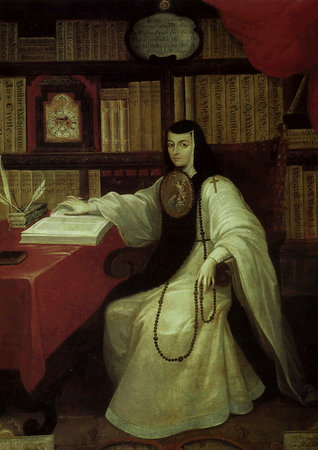
➼ The Swing
Details
By Jean-Honoré Fragonard
1767
Made of oil on canva
Found in Wallace Collection, London
Form
Pastel palette; light brushwork.
Figures are small in a dominant garden-like setting.
Use of atmospheric perspective.
Puffy clouds; rich vegetation; abundant flowers; sinuous curves.
Symbolically a dreamlike setting.
Patronage and Content
Commissioned by an unnamed “gentleman of the Court:” a painting of his young mistress on a swing; in an early version, a bishop is pushing the swing with the gentleman admiring his mistress’s legs from below.
In the finished painting, the older man is no longer a priest, a barking dog has been added, and Falconet’s sculpture of Menacing Love comments on the story.
The patron in the lower left looks up the skirt of a young lady who swings flirtatiously, boldly kicking off her shoe at a sculpture.
The dog in the lower right corner, generally seen as a symbol of fidelity, barks in disapproval at the scene before him.
Context
Fragonard answers the libertine intentions of his patron by painting in the Rococo style.
Fragonard often used different styles at the same time, and he seems to have seen the Rococo as particularly appropriate for an erotic scene.
An intrigue painting; the patron hides in a bower; the garden sculpture of Menacing Love asks the lady to be discreet and may be a symbol for the secret hiding of the patron.

➼ Still Life in Studio
Details
By Louis-Jacques-Mande Daguerre
1837
Daguerreotype
French Photographic Society, Paris
Form
Photograph reproduces a variety of textures: fabric, wicker, plaster, framed print, etc.
Inspired by painted still lifes, such as vanitas paintings.
Context
New art form proclaimed while referencing older art forms.
Daguerreotypes have a shiny surface and a sharp eye for detail.
No negative; therefore, copies could not be made.
Long exposure times required.
Produced on a metallic surface; photos have a glossy finish.
➼ Starry Night
Details
By Vincent van Gogh
1889
Oil on canvas
Found in Museum of Modern Art, New York
Form
Thick, short brushstrokes.
Heavy application of paint called impasto.
Parts of the canvas can be seen through the brushwork; artist need not fill in every part of the surface.
Strong left-to-right wave-like impulse in the work broken only by the tree and the church steeple.
The tree looks like green flames reaching into a sky that is exploding with stars over a placid village.
Context
The mountains in the distance are the ones that Van Gogh could see from his hospital room in Saint-Rémy; steepness exaggerated.
Combination of images: Dutch church, crescent moon, Mediterranean cypress tree.
Cypresses were often associated with cemeteries.
Landscape painting was popular in the late nineteenth century as a reaction to the industrialization of cities.
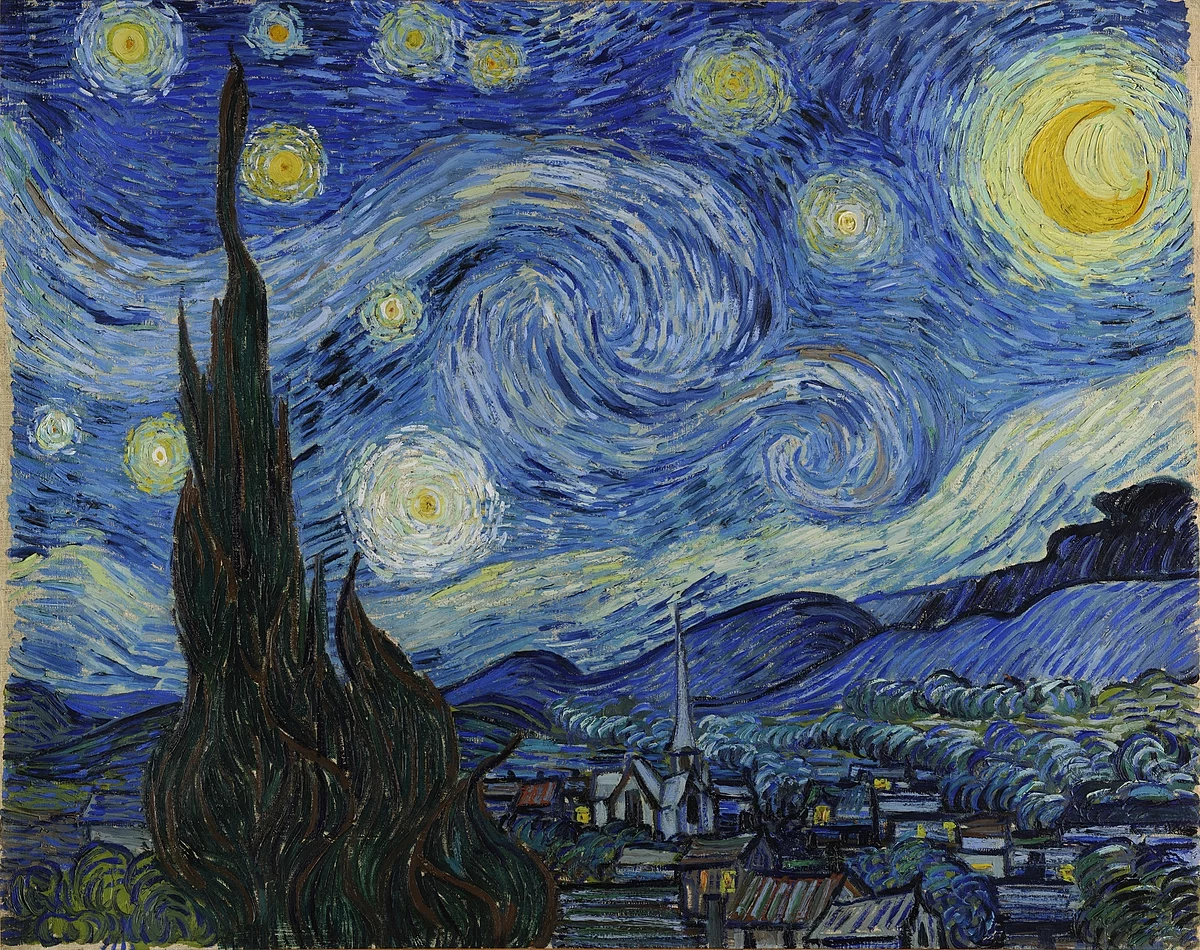
➼ The Scream
Details
By Edvard Munch
1893
Tempera and pastels on cardboard
Found in National Gallery, Oslo
Form and Content
The figure walks along a wharf; boats are at sea in the distance.
Long, thick brushstrokes swirl around the composition.
The figure cries out in a horrifying scream; the landscape echoes his emotions.
Discordant colors symbolize anguish.
Emaciated, twisting stick figure with skull-like head.
Function: Painted as part of a series called The Frieze of Life; a semi autobiographical succession of paintings.
Context
Said to have been inspired by an exhibit of a Peruvian mummy in Paris.
The work prefigures Expressionist art.
The work is influenced by Art Nouveau swirling patterns.
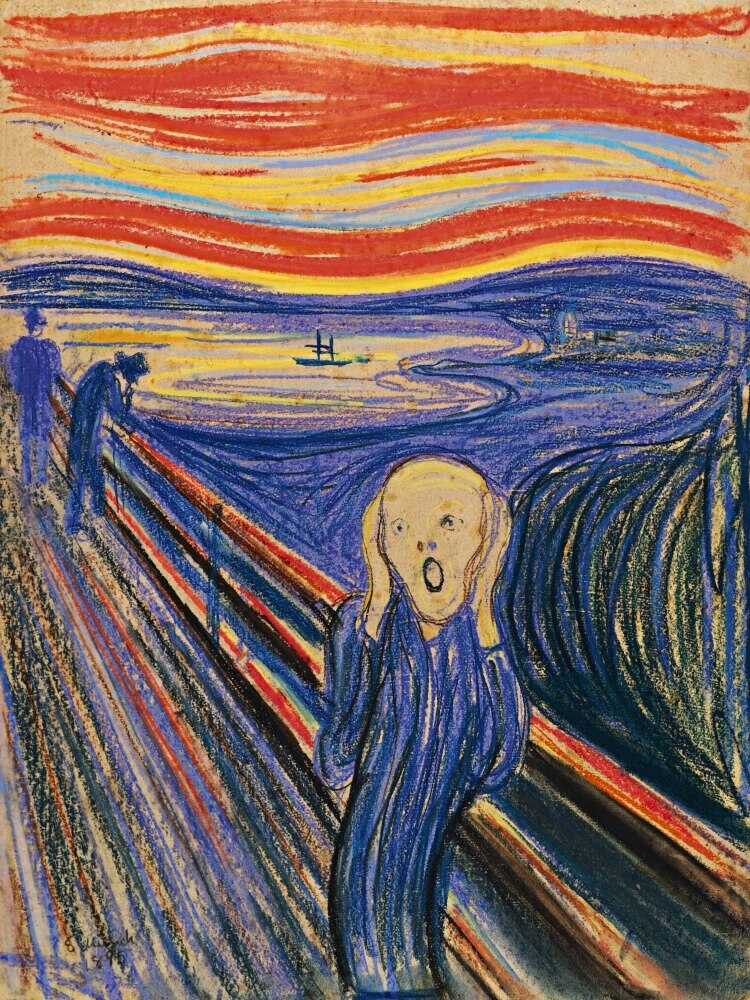
➼ The Kiss
Details
By Gustav Klimt
1907–1908
Oil and gold leaf on canvas
Found in Austrian Gallery, Vienna
Form
Little of the human form is actually seen: two heads four hands, two feet.
The bodies are suggested under a sea of richly designed patterning.
The work is spaced in an indeterminate location against a flattened background.
Context
The male figure is composed of large rectangular boxes; the female figure is composed of circular forms.
The work suggests all-consuming love; passion; eroticism.
The use of gold leaf is reminiscent of Byzantine mosaics
The work is influenced by gold applied to medieval illuminated manuscripts.
Part of a movement called the Vienna Succession, which broke away from academic training in schools at that time.
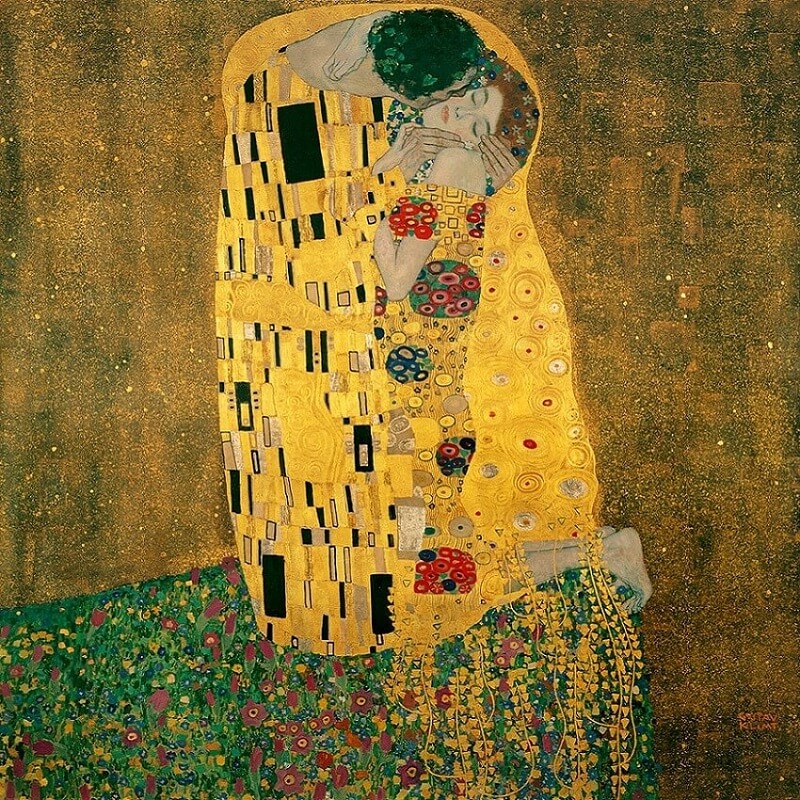
➼ Louis Sullivan, Carson, Pirie, Scott and Company Building
Details
1899–1903
Iron, steel, glass, and terra cotta
Found in Chicago
Form
Horizontal emphasis on the exterior mirrors the continuous flow of floor space on the interior.
The exterior is covered in decorative terra cotta tiles; original interior ornamentation elaborately arranged around lobby areas, hallways, elevator; interior ornamentation now lost.
The architect designed maximum window areas to admit light, but also to make displays visible from the street.
Nonsupportive role of exterior walls; held up by an interior framework.
Open ground plan allows for free movement of customers and goods.
Function: A department store on a fashionable street in Chicago.
Context
Some historical touches exist in the round entrance arches and the heavy cornice at the top of the building.
Cast iron decorative elements transformed the store into a beautiful place to buy beautiful things.
Shows the influence of Art Nouveau in decorative ironwork on the entrance.
Sullivan motto: “Form follows function.”
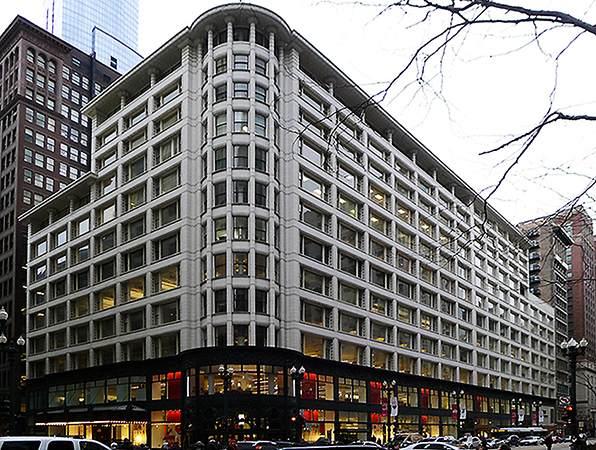
➼ Goldfish
Details
By Henri Matisse
1912
Oil on canvas
Formerly in Pushkin Museum of Art, Moscow, Russia
Form
Strong contrasts of color.
Thinly applied colors; the white of the canvas shows through.
Energetic, painterly brushwork.
Broad patches of color anticipate color-field painting later in the century.
Content
Still-life painting.
Compare to Ruysch, Fruits and Insects, and Daguerre, Still Life in Studio.
Context
May have been in response to a trip in Morocco, where Matisse noted how the local population would daydream for hours, gazing into goldfish bowls. Form, color, and subject matter were inspired by this trip.
Admired the relaxed and contemplative lifestyle of the Moroccans, which symbolized a meditative state of mind and a sense of paradise lost to Europeans.
May have been influenced by the decorative quality of Asian art and diverse cultures from North Africa.
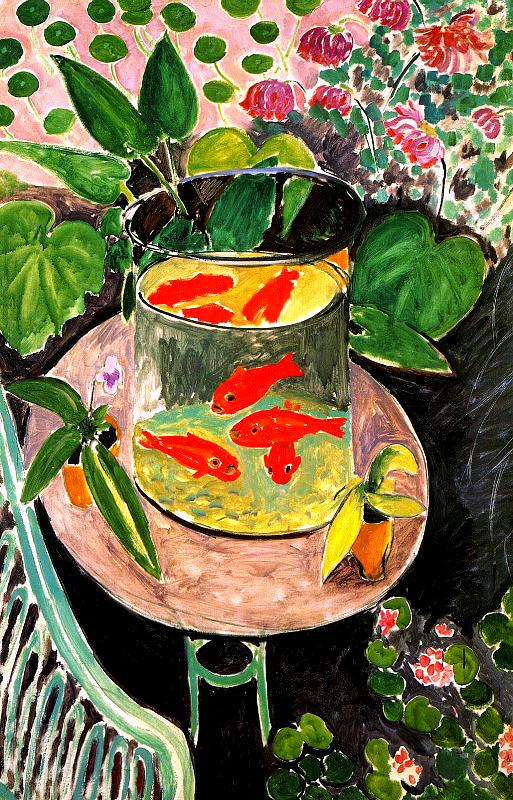
➼ Improvisation 28 (2nd Version)
Details
By Vassily Kandinsky
1912
Oil on canvas
Found in Guggenheim Museum, New York
Form
Strongly articulated use of black lines.
Colors seem to shade around line forms.
Content
Using schematic means, Kandinsky depicts cataclysmic events on the left (boat and waves—a deluge, a serpent, a cannon) and a sense of spiritual salvation on the right (a couple embrace, a candle, a church on a hill).
Context
Kandinsky wanted the viewer to respond to a painting the way one would to an abstract musical composition: a concerto, a sonata, a symphony.
The artist felt that sound and color were linked; for example, it was possible to hear color.
He used words such as “composition” and “improvisation” in the titles of his works, words associated with musical composition.
Kandinsky’s works have a relationship to atonal music, which was evolving at this time.
Movement toward abstraction; representational objects suggested rather than depicted.
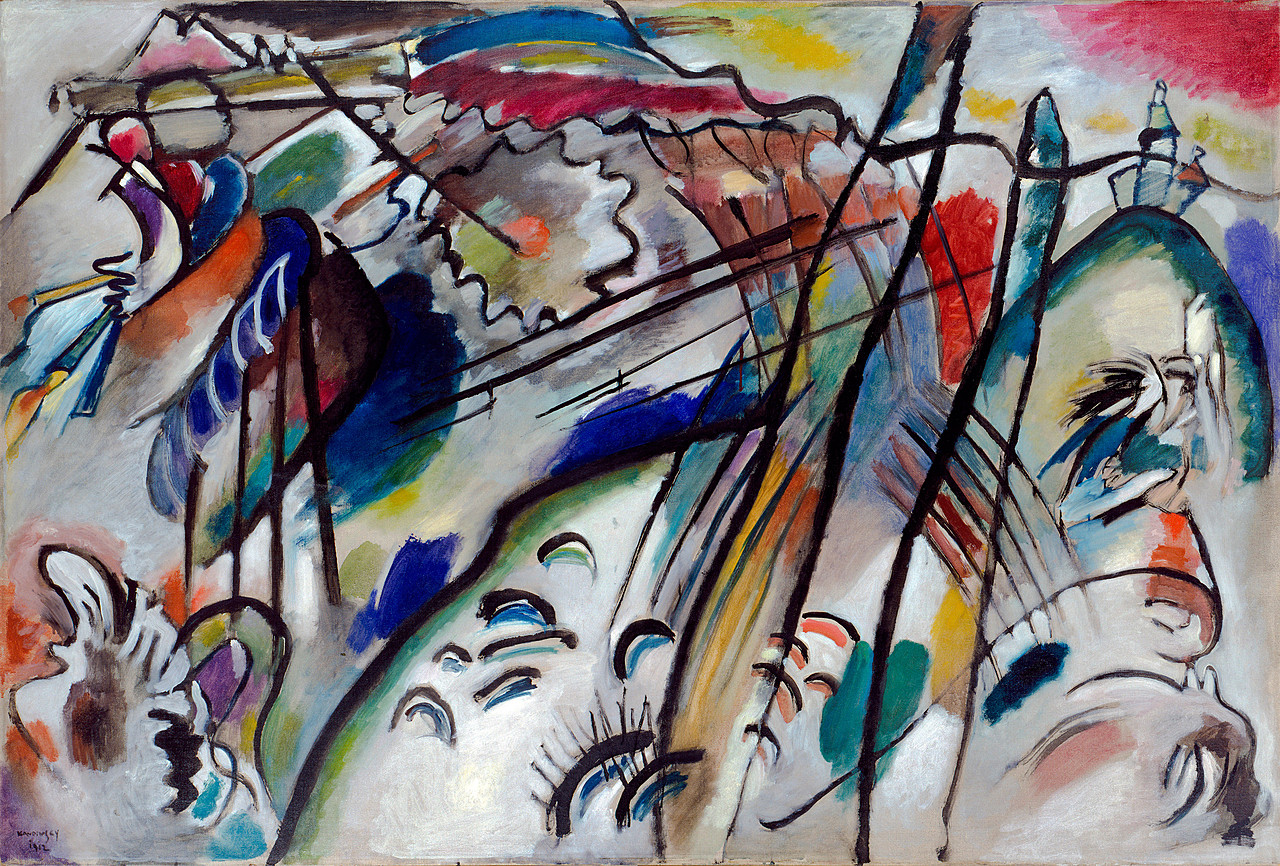
➼ Self-Portrait as a Soldier
Details
By Ernst Ludwig Kirchner
1915
Oil on canvas
Found in Allen Memorial Art Museum, Oberlin College, Oberlin, Ohio
Form
Nightmarish quality.
Colors are nonrepresentational but symbolic, chosen to provide a jarring impact. Expressive quality of horrified facial features and grim surroundings.
Tilted perspective moves things closer to the picture plane.
Main figure has a drawn face, with a cigarette hanging loosely from his lips.
The eyes are unseeing and empty, without pupils; the iris reflects the blue of his uniform.
The bloody stump of a hand represents losses in war, loss of the artist’s ability to paint, his creativity, his artistic vision, and his inspiration.
Sharp angular lines reinforce a sense of violence and anxiety.
Context
Kirchner became an “unwilling volunteer,” a driver in the artillery in World War I, to avoid being drafted into the infantry.
He is wearing the uniform of his field artillery regiment.
He was declared unfit for service; he had lung problems and weakness and suffered a mental breakdown—there is scholarly debate as to whether he faked these ailments to avoid service.
This self-portrait was painted during a recuperation period.
His life was plagued by drug abuse, alcoholism, and then paralysis.
The artist feared that war would destroy his creative powers.

➼ Memorial Sheet for Karl Liebknecht
Details
By Käthe Kollwitz
1919–1920
Woodcut
A Private Collection
Form
Stark black and white of the woodcut used to magnify the grief.
Human grief dominates.
Patronage: Family of Liebknecht asked Kollwitz to memorialize him.
Technique
Wood-block print.
Kollwitz used this technique to reinforce the emotions depicted in the scene.
She liked the “primitive” quality that wood-block prints could render.
Context
Liebknecht was among the founders of the Berlin Spartacus League, which became the German Communist Party.
In 1919, Liebknecht was shot to death during a Communist uprising in Berlin called the Spartacus Revolt (named for the slave who led a revolt against the Romans in 73 B.C.E.).
Liebknecht was held to be a martyr in the Communist cause.
There are no political references in the woodcut.
Themes of war and poverty dominate the artist’s oeuvre.
She often emphasized the theme of women grieving over dead children; her son died in World War I; the artist then became a socialist.

➼ Les Demoiselles d’Avignon
Details
By Pablo Picasso
1907
Oil on canvas
Found in Museum of Modern Art, New York
Content
Depicts five prostitutes in a bordello in Avignon Street in Barcelona, each posing for a customer.
Poses are not traditionally alluring but awkward, expressionless, and uninviting.
Form
The three on the left are more conservatively painted; the two on right more radical; reflects a dichotomy in Picasso.
Multiple views are expressed at the same time.
Depth is limited, but ambiguous and ever shifting.
The painting has semitransparent passages.
Context
This is the first cubist work, influenced by late Cézanne and perhaps African masks (faces on the right) and ancient Iberian sculpture (figure on the left).
Influenced by Gauguin’s so-called Primitivism.
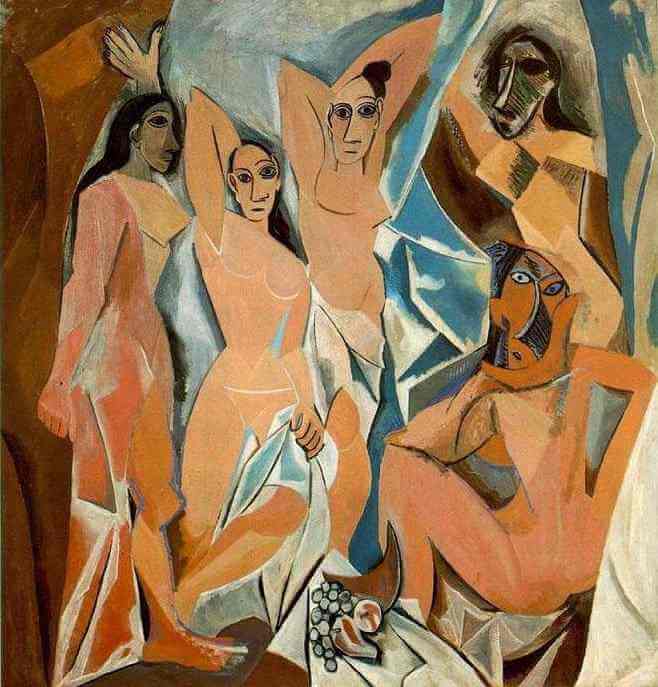
➼ The Portuguese
Details
By Georges Braque
1911
Oil on canvas
Art Museum, Basel, Switzerland
Form
Braque rejected naturalistic and conventional painting.
Fractured forms; breaking down of objects into smaller forms.
Clear-edged surfaces at the front of the picture plane, not recessed in space.
Nearly monochrome.
Context
Analytical Cubism; Braque worked in concert with Pablo Picasso to develop this style.
This is not a portrait of a Portuguese musician, but rather an exploration of shapes.
The only realistic elements are the stenciled letters and numbers; perhaps they suggest a dance hall poster behind the guitarist, a café-like atmosphere.

➼ The Steerage
Details
By Alfred Stieglitz
1907
photogravure
A private collection
Form
Interested in compositional possibilities of diagonals and lines acting as framing elements.
Diagonals and framing effects of ladders, sails, steam pipes, etc.
Stieglitz photographed the world as he saw it; he arranged little, and allowed people and events to make their own compositions.
Influenced by experimental European painting; compared with a Cubist drawing by Picasso, Cubist-like in arrangement of shapes and tonal values.
Content
Steerage: the part of a ship reserved for passengers with the cheapest tickets.
Depicts the poorest passengers on a ship traveling from the United States to Europe in 1907; they were allowed out for air for a limited time.
Some may have been people turned away from entrance to the United States; more likely, they were artisans whose visas had expired and were returning home.
Context
The work depicts social divisions in society.
Published in October 1911 in Camera Work.
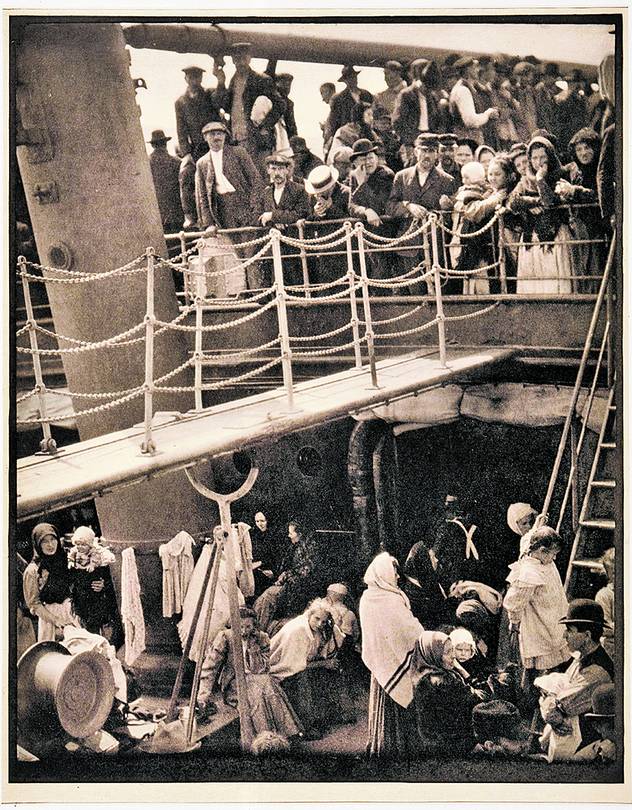
➼ Fountain
Details
By Marcel Duchamp
Originally 1917; this version is 1950
readymade glazed sanitary china with black paint
Found in Philadelphia Museum of Art, Pennsylvania
Form
Ready-made sculpture; actually a found object that Duchamp deemed to be a work of art.
Signed by the “artist,” R. Mutt, a pun on the Mutt and Jeff comic strip and Mott Iron Works.
Item purchased from a sanitary-ware supplier and submitted to the Society of Independent Artists, a group that Duchamp helped to found.
Function and History
Entered in an unjuried show, the work was refused—narrowly voted out by the organizers.
Thought to be indecent, not fit to show women.
Duchamp resigned in protest.
It is not fully understood why Duchamp resigned; it may have come from his experience exhibiting an earlier work Nude Descending a Staircase No. 2 to the Salon des Indépendants in Paris; although the work was illustrated in the show’s catalog, Duchamp was asked to remove it a few days before the opening.
He removed the object but felt betrayed; said it was a turning point in his life.
Fountain can be seen as an experimental replay by Duchamp, testing the commitment of the new American Society to freedom of expression and tolerance of new conceptions about art.
Context
The title is a pun: a fountain spouts liquid, a urinal collects it.
The placing of the urinal upside down is an added irony.
The rotation of Fountain may symbolize seeing something familiar from a new perspective.
The original is now lost; Duchamp oversaw the “remaking” of a few models in 1964.
➼ Object (Le Dejéuner en fourrure)
Details
By Meret Oppenheim
1936
fur-covered cup, saucer, and spoon
Found in Museum of Modern Art, New York
Form: An assemblage.
Context
Said to have been done in response to Picasso’s claim that anything looks good in fur; Oppenheim said to respond, “Even this cup and saucer?”
Erotic overtones.
Combination of unalike objects: fur-covered teacup, saucer, and spoon. The tea cup was purchased at a department store; the fur is the pelt of a Chinese gazelle.
A contrast of textures: fur delights the touch, not the taste; cups and spoons are meant to be put in the mouth.
Oppenheim did not title the work, but the Surrealist critic, Andre Breton, called the piece Le Déjeneur en fourrure, or Luncheon in Fur, a title that references Édouard Manet’s Luncheon on the Grass as well as the erotic novel by Leopold von Sacher-Masoch called Venus in Furs.
Chosen by visitors to a Surrealist show in New York as the quintessential Surrealist work of art.
Because fame came to Oppenheim so young (she was twenty-two when she produced this work), it inhibited her growth as an artist.
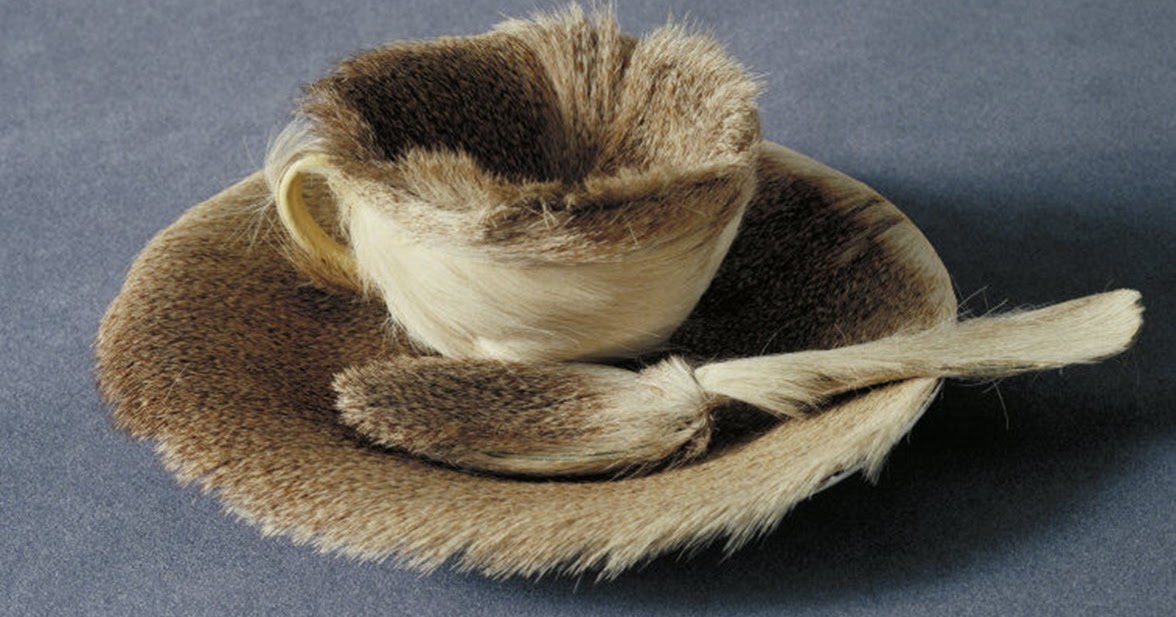
➼ The Two Fridas
Details
By Frida Kahlo
1939
oil on canvas
Found in Museum of Modern Art, Mexico City
Content
On the left: Kahlo is dressed as a Spanish lady in white lace, linking her to a European heritage.
On the right: Kahlo dressed as a Mexican peasant—the stiffness and provincial quality of Mexican folk art was a direct inspiration for the artist.
Behind is a barren landscape; two figures sit against a wildly active sky.
Context
There is a juxtaposition to two self-portraits.
Kahlo’s two hearts are joined together by veins that are cut by scissors at one end and lead to a portrait of her husband, artist Diego Rivera, at the other; painted at the time of their divorce.
The vein acts as an umbilical cord; symbolism: Rivera as both husband and son.
Blood on her lap suggests many abortions and miscarriages; also, surgeries related to her health issues.
Kahlo rejected the label Surrealism for her artwork.
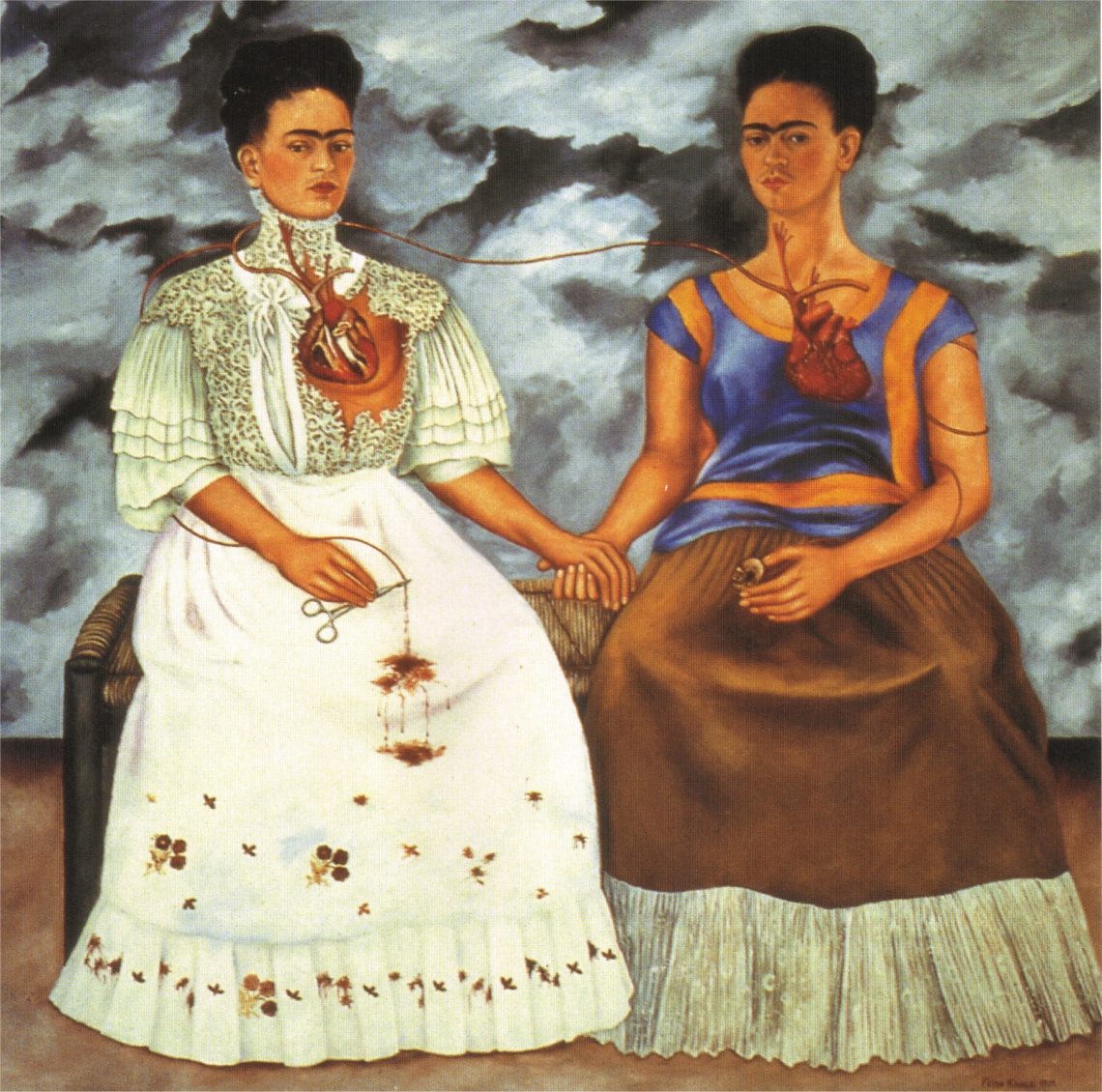
➼ The Jungle
Details
By Wifredo Lam
1943
gouache on paper mounted on canvas
Found in Museum of Modern Art, New York
Form
Crescent-shaped faces suggest African masks and the god Elegua.
Rounded backs, thin arms and legs, pronounced hands and feet.
Long vertical lines suggest sugarcane, which is grown in fields, not jungles.
Context
Cuban-born artist whose career took him to Europe and the United States.
The artist was interested in Cuba’s mixture of Hispanic and African cultures.
This work was “intended to communicate a psychic state.”
The work addresses the history of slavery in colonial Cuba.
Influences include African sculpture; Cubist works; Surrealist paintings (Lam was a member of the Surrealist movement in Paris).
The painting contrasts a Cuban landscape with a tourist image of Cuba as a tropical paradise.
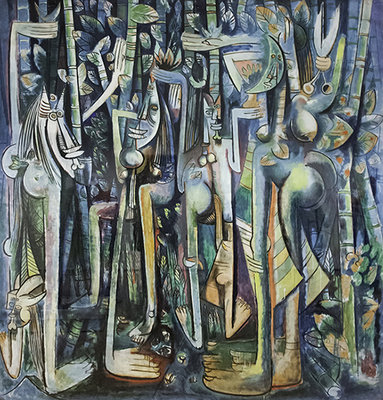
➼ Illustration from The Results of the First Five-Year Plan
Details
By Varvara Stepanova
1932
photomontage
Found in Museum of the Revolution, Moscow, Russia
Form and Function
Graphic art for political and propaganda purposes; a photomontage.
Red color dominates—the color of Communist Soviet Union.
A large portrait of Lenin dominates; although deceased, his image is used to stimulate patriotism.
Masses of people below illustrate the popularity of the Five-Year Plan.
CCCP (Союз Советских Социалистических Республи) is a Russian abbreviation for the Soviet Union.
Context
Stepanova was one of the main figures in the Russian avant-garde movement.
Influenced by Cubism and Futurism.
Five-Year Plan:
Soviet practice of increasing agricultural and industrial output in five years.
Launched in 1928, considered complete in 1932.
Emphasis on growth of heavy industry rather than consumer goods.
Huge increases in electrical output (dominant industrial symbol in the work).
The failures of the five-year plan are overlooked in this representation (famine, extreme poverty, political oppression); instead it is a propaganda statement of the virtues of the Stalinist state.
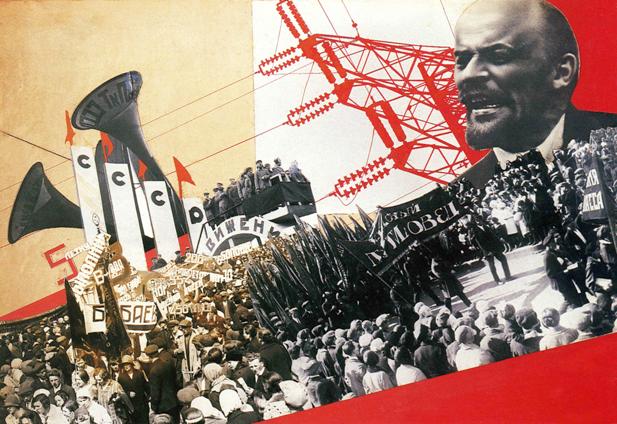
➼ Composition with Red, Blue and Yellow
Details
By Piet Mondrian
1930
oil on canvas
Found in Kunsthaus,Zurich
Form
Only primary colors used—red, yellow, and blue—plus the neutral colors, white and black.
Severe geometry of form; only right angles; grid-like forms.
No shading of colors.
Context
The artist is interested in the material properties of paint, not naturalistic depictions.
The artist expresses ideas using abstract elements—that is, line and color.
Influenced by Cubism.
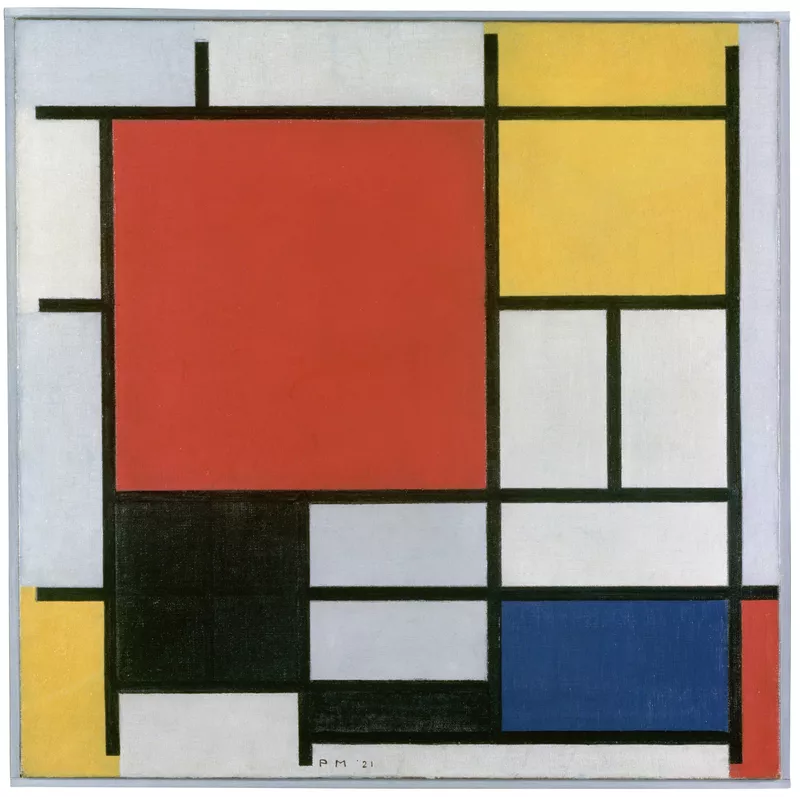
➼ Fallingwater
Details
By Frank Lloyd Wright
1936–1939
reinforced concrete, sandstone, steel, and glass
Found in Bear Run, Pennsylvania
Form
Cantilevered steel-supported porches extend over a waterfall.
The accent is on horizontal lines—as opposed to the verticality of much of twentieth-century architecture.
The architecture is in harmony with the site.
The living room contains a glass curtain wall around three of the four sides; the building embraces the woods around it.
The floor of the living room and the walls of building are made from the stone of the area.
The hearth (physically and symbolically) is the center of the house, an outcropping of natural stones surrounds it.
The interior shows a suppression of space devoted to hanging a painting; Wright wanted the architecture to dominate.
The ground plan and design is irregular and complex.
Only two colors used: light ochre for the concrete and Cherokee red for the steel.
Context: Late expression of Prairie School ideas.
Function and Patronage: Weekend retreat for the Kaufmann family, who owned a department store in Pittsburgh, Pennsylvania.
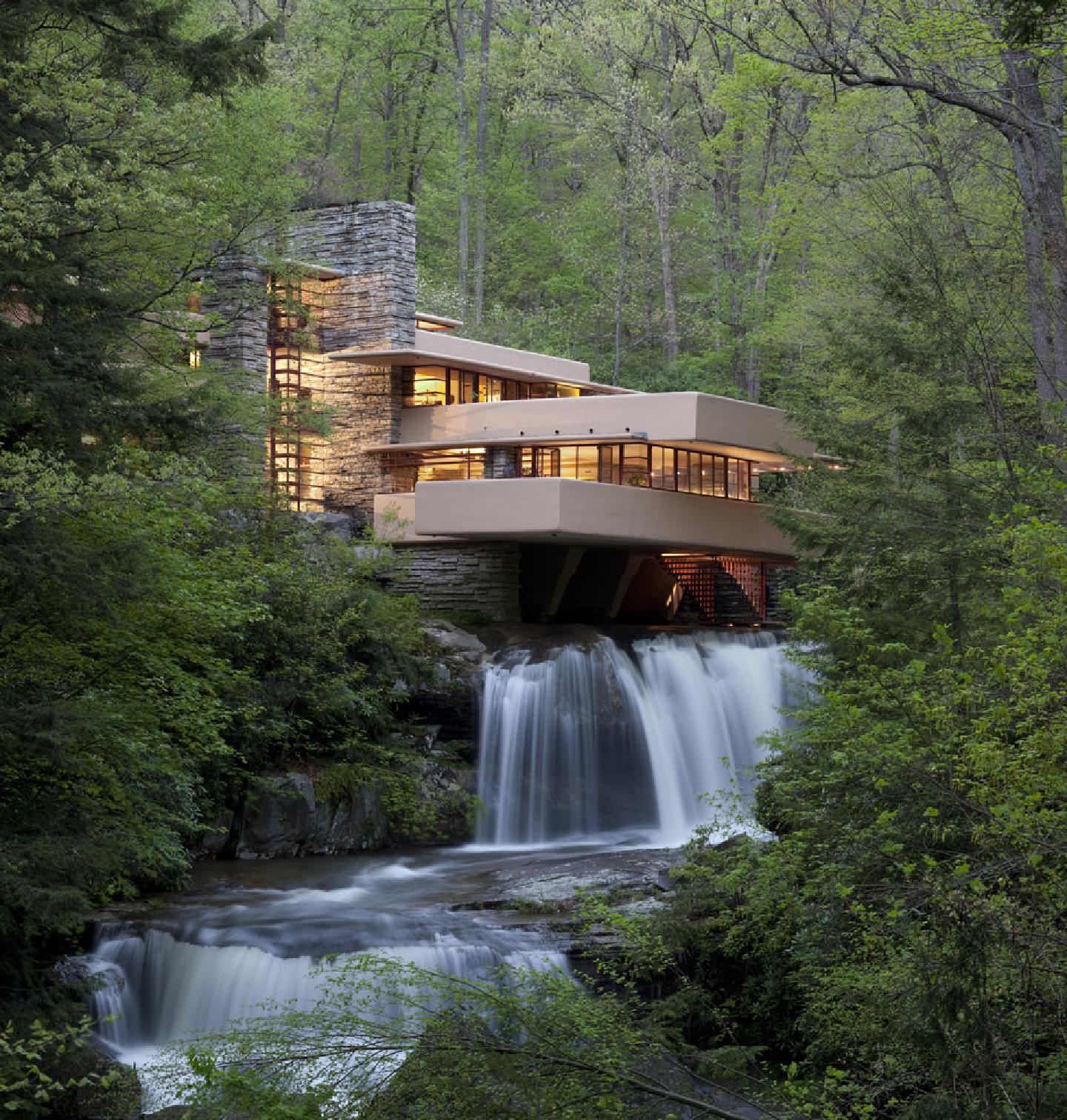
➼ Villa Savoye
Details
By Le Corbusier
1929
steel and reinforced concrete
Found in Poissy-sur-Seine, France
Form
Boxlike horizontal quality; an abstraction of a house.
The main part of the house is lifted off the ground by narrow pilotis—thin freestanding posts.
The house appears to float on pilotis; allows air to circulate around the base of the house.
The turning circular carport on the bottom floor enables family members to enter the house directly from their car.
All space is utilized, including the roof, which acts as a patio.
The roof terraces bring the outdoors into the house.
Subtle colors: white on exterior symbolizes modern cleanliness and healthful living.
Open interior is free of many walls.
Some furniture is built into the walls.
Ribbon windows wind around the second floor.
Streamlined look.
Living spaces that are surrounded by glass face an open courtyard-type setting on the second floor.
Function and Patronage
A three-bedroom country house with servants’ quarters on the ground floor.
Built in suburban Paris as a retreat for the wealthy.
Patrons: Pierre and Emilie Savoye.
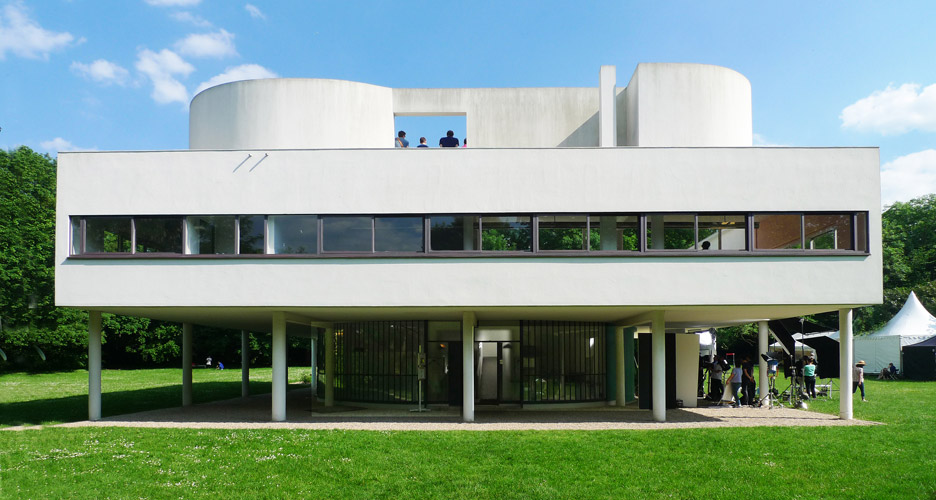
➼ Seagram Building
Details
By Ludwig Mies van der Rohe and Philip Johnson
1954–1958
steel frame with glass curtain wall and bronze
Found in New York
Function: 38-story corporate headquarters of the Seagram Liquor Company.
Form
Bronze veneer gives the skyscraper a monolithic look; bronze is maintained yearly to keep the same color.
Set back from Park Avenue on a wide plaza balanced by reflecting pools.
Interplay of vertical and horizontal accents.
Mullions stress the verticality of the internal frame.
Context
Minimalist architecture.
Monolith style expresses corporate power.
Mies’s saying of “Less is more” can be seen in this building with its great simplicity, geometry of design, and elegance of construction.
Mies also said, “God is in the details;” truthful buildings express their structure, not hide it.
Steel and glass skyscrapers and curtain wall construction became the model after World War II.
A triumph of the International Style of architecture.
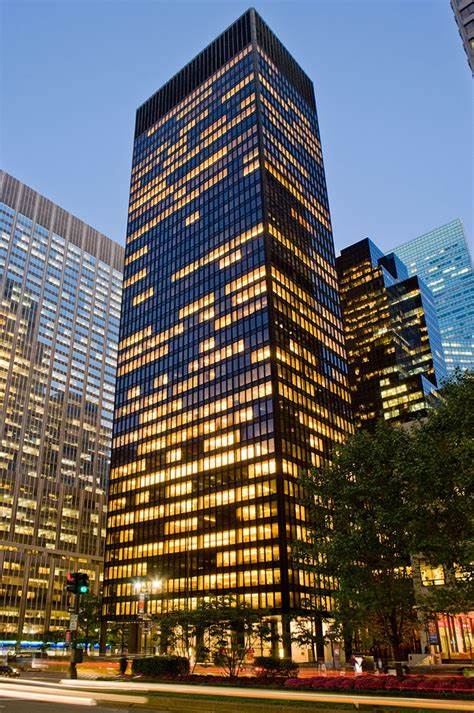
➼ The Migration of the Negro, Panel no. 49
Details
By Jacob Lawrence
1940–1941
casein tempera on hardboard
Found in Museum of Modern Art, New York
Form
The work illustrates the collective African-American experience; therefore, there is little individuality in the figures.
Forms hover in large spaces.
Angularity of forms.
Tilted tabletops show the surface of the table.
Flat, simple shapes.
Unmodulated colors.
Collective unity achieved by painting one color across many panels before going on to the next color; overall color unity in the series unites each painting.
Content
This scene involves a public restaurant in the North; segregation emphasized by the yellow poles that zigzag down the center.
Whites appear haughty and self-engrossed.
African-Americans appear faceless; forms reveal their bodies and personalities.
Context
One of a series of 60 paintings that depicts the migration of African-Americans from the rural South to the urban North after World War I.
Negroes escaping the economic privation of the South.
Narrative painting in an era of increasing abstraction.
Cinematic movement of views of panels: some horizontal and others vertical.
Influenced by the Italian masters of the fourteenth and fifteenth centuries; used tempera paint.
The Phillips Collections in Washington, D.C., and the Museum of Modern Art in New York bought the collection and it was split.
The Phillips took the odd-numbered paintings; the Museum of Modern Art has the even-numbered ones.
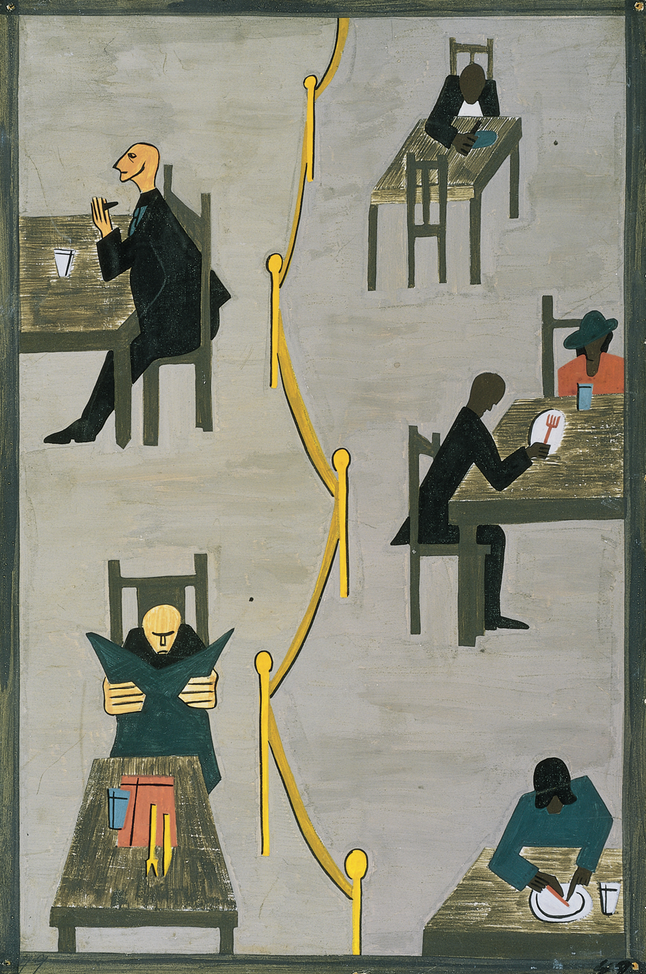
➼ Dream of a Sunday Afternoon in the Alameda Park
Details
By Diego Rivera
1947–1948
fresco
Found in Museo Mural Diego Rivera, Mexico City
Form
50-foot-long fresco, 13 feet high.
Horror vacui; didactic painting.
Colorful painting.
Revival of fresco painting, a Mexican specialty.
Placement
Originally in the lobby of the Hotel del Prado.
After a 1985 earthquake destabilized the hotel, the fresco was placed in a museum adjacent to Alameda Park, Mexico City’s first city park—built on the grounds of an Aztec marketplace.
Content
Three eras of Mexican history depicted from left to right:
Conquest and colonization of Mexico by the Spanish.
Porfirio Diaz dictatorship.
Revolution of 1910 and the modern world.
Depicts a who’s who of Mexican politics, culture, and leadership:
Sor Juana, in nun’s habit, at left center.
Benito Juárez, five-term president of Mexico, left at top.
General Santa Ana handing the keys of Mexico to General Winfield Scott.
Emperor Maximilian and Empress Carlota.
José Marti, father of Mexican independence (tipping his hat).
General Porfirio Díaz, with medals, asleep.
A police officer ordering a family out of an elitist park.
Francisco Madero, a martyred president.
José Posaro, artist and Rivera hero.
Rivera is in the center, at age ten, holding hands with Caterina (“Death”) and dreaming of a perfect love (Kahlo is behind him holding a yin/yang symbol—a symbol of Kahlo and Rivera’s relationship).

➼ Woman I
Details
By Willem de Kooning
1950–1952
oil on canvas
Found in Museum of Modern Art, New York
Form
Ferocious woman with great fierce teeth and huge eyes.
Large, bulbous breasts satirize women who appear in magazine advertising; smile said to be influenced by an ad of a woman selling Camel cigarettes.
Jagged lines create an overpowering image.
The smile is a cut out of a female smile from a magazine advertisement.
Blank stare; frozen grin.
Ambiguous environment: vagueness, insecurity.
Thick and thin black lines dominate.
Context
Combination of stereotypes; ironic comment on the banal and artificial world of film and advertising.
Commentary on the female form in art history.
Is she aggressive? Or have aggressions been committed against her? Or both?
One of a series of six paintings on this theme.
Influenced by everything from paleolithic goddesses to pin-up girls
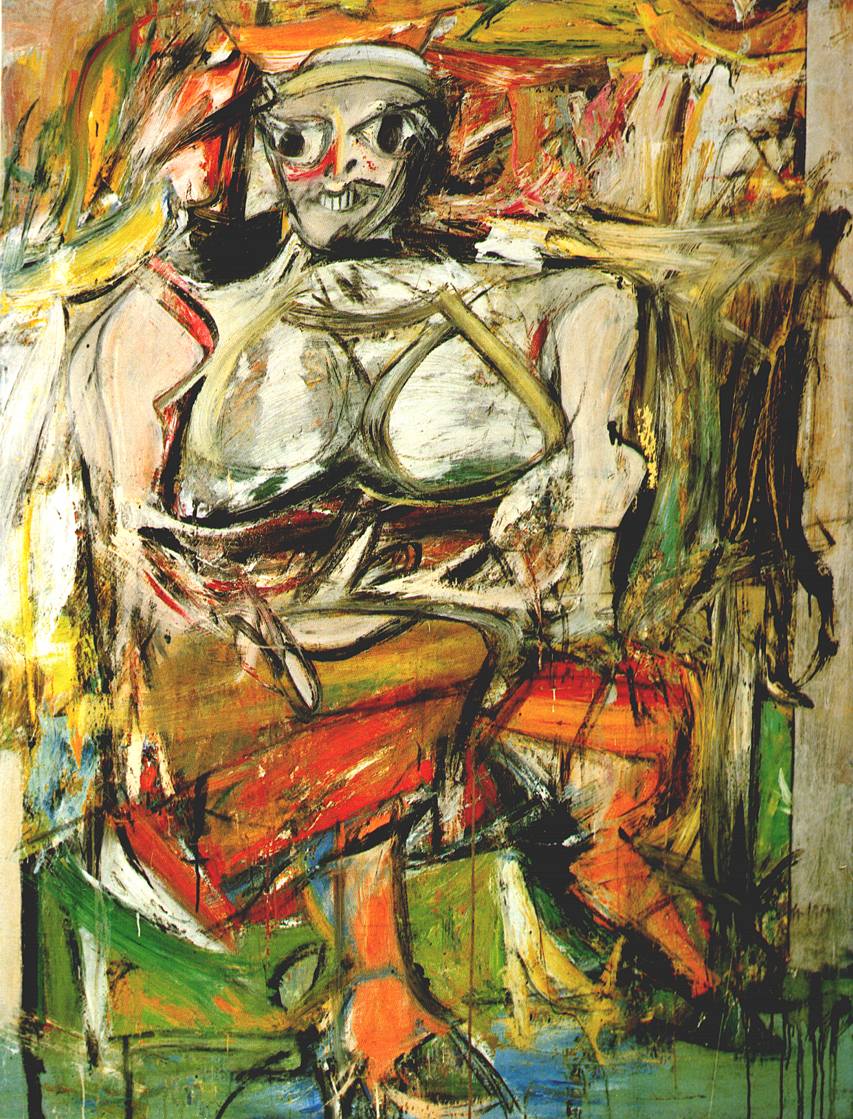
➼ The Bay
Details
By Helen Frankenthaler
1963
acrylic on canvas
Found in Detroit Institute of Arts, Detroit, Michigan
Form
Painted directly on an unprimed canvas; canvas absorbs the paint more directly.
Use of runny water-based acrylic paint.
Soak-stained technique.
Use of landscape as a starting point, a basis for imagery in the works.
The two-dimensionality of the canvas is accentuated.
Context and Interpretation: Artist worked in the avant-garde New York School at mid-century.
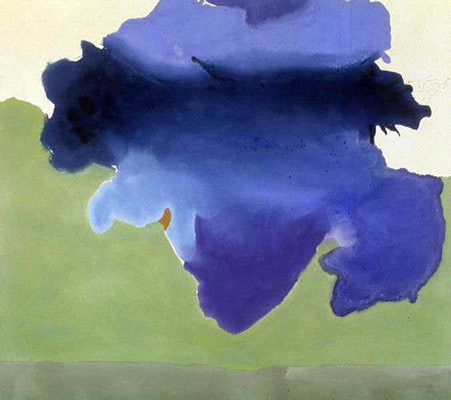
➼ Marilyn Diptych
Details
By Andy Warhol
1962
oil, acrylic, silkscreen enamel on canvas
Found in Tate Gallery, London
Form and Content
Marilyn Monroe’s public face appears sequentially as if on a roll of film.
Fifty images from a film still from a movie, Niagara (1953).
Social characteristics magnified: brilliance of blonde hair, heavily applied lipstick, seductive expression.
Private persona of the individual submerged beneath the public face.
Marilyn’s public face appears highlighted by bold, artificial colors.
Left, in color, represents her in life; right, in black and white, represents her in death; work done four months after her tragic death.
Repetition of faces reflects the repetition of the number of times Marilyn appeared before the public; sometimes overexposed, sometimes underexposed.
Materials and Technique
Silkscreen printing technique applies photographic images in rectangular shapes onto a canvas background.
Silkscreen diminishes the role of shading and emphasizes broad planes and unmodulated color.
Diptych format suggests almost a religious presence.
Context
Cult of celebrity; Monroe was a famous movie star of the 1950s.
Private persona of Marilyn submerged beneath the public face(s).
Repeated imagery drains the image of Monroe of meaning.
Reproduction of many denies the concept of the unique work of art.
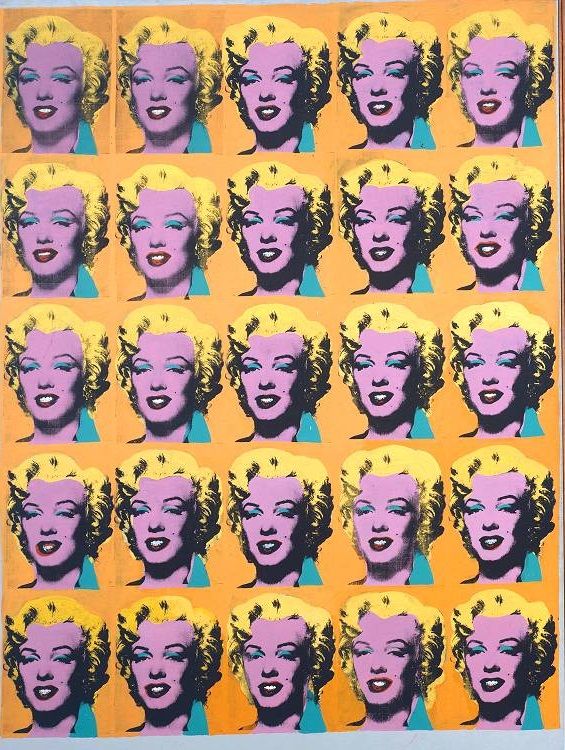
➼ Lipstick (Ascending) on Caterpillar Tracks
Details
By Claes Oldenburg
1969–1974
cor-ten steel, steel, aluminum, and cast resin, painted with polyurethane enamel
Found in Yale University, New Haven, Connecticut
Function
First installed, secretly, on Beinecke Plaza, New Haven, in 1969.
Intended as a platform for public speakers; rallying point for anti-Vietnam-era protests.
Materials
Sculpture made of inexpensive and perishable materials (plywood tracks and an inflatable vinyl balloon tip).
Refurbished with steel and aluminum; reinstalled in 1974 in front of Morse College, at Yale—not its original location.
Context
Tank-shaped platform base with lipstick ascending—antiwar symbolism.
Male and female forms unite: themes of death, power, desire, and sensuality.
First monumental sculpture by Oldenburg.
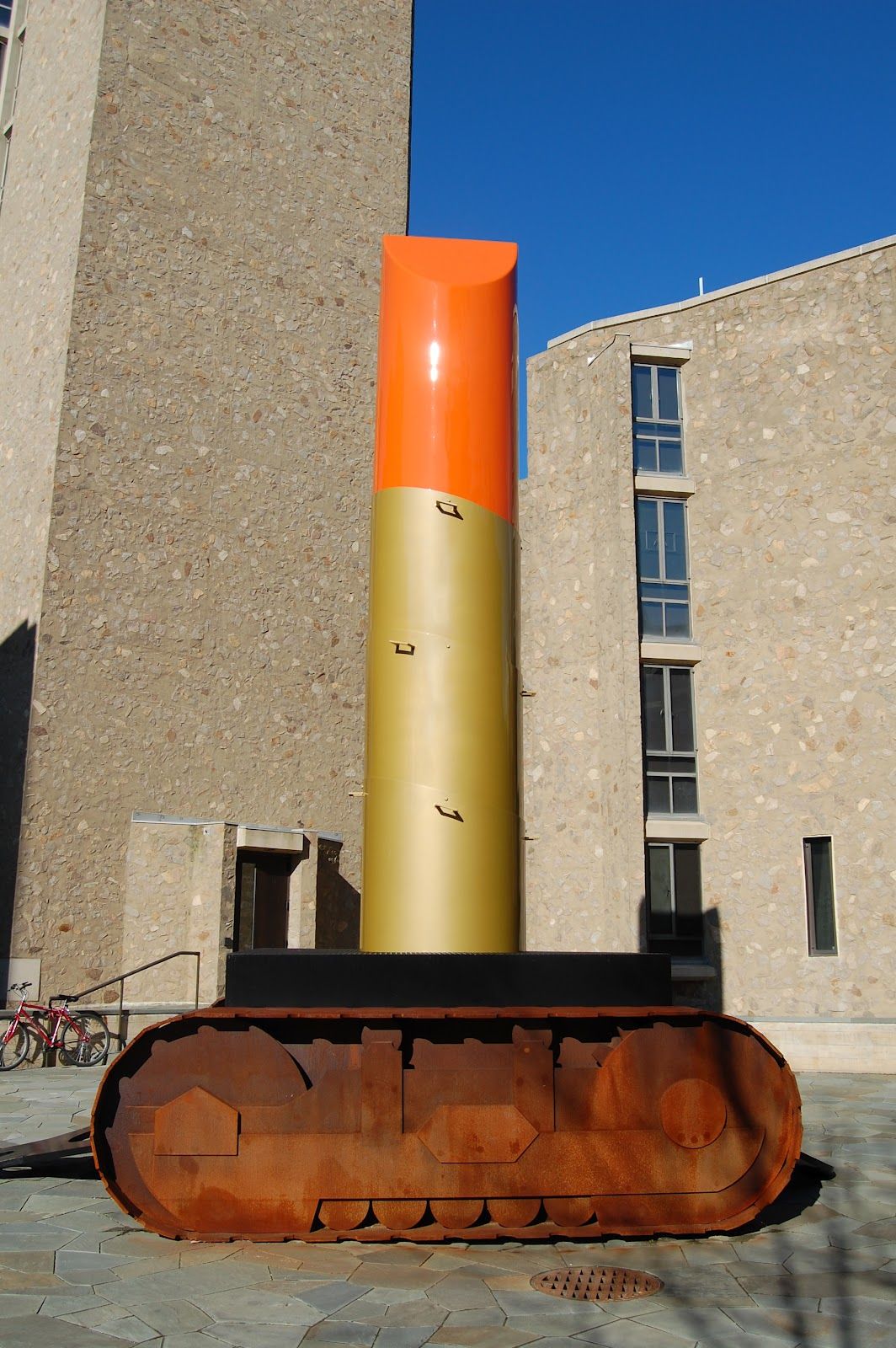
➼ Narcissus Garden
Details
By Yayoi Kusama
first seen in 1966
marble installations
Found in Venice
Function and History
The artist originally featured the work as an uninvited participant in the 1966 Venice Biennale.
Fifteen hundred large, mirrored, plastic balls were placed on a lawn under a sign that said “Your Narcissism for Sale.”
The viewer is reflected seemingly into infinity in the mirrored surfaces.
The artist offered the balls for sale for 1,200 lire ($2 each) as a commentary on the commercialism and vanity of the current art world.
The installation later moved to water, where the floating balls reflect the natural environment—and the viewers—around the work; water placement makes a stronger connection to the ancient myth.
Balls move with the currents of the water and wind, reflecting organically made, ever-changing viewpoints.
The installation has been exhibited in many places around the world, both in water and in dry spaces
Context
Narcissus Garden references the ancient myth of Narcissus, a young man who is so enraptured by his image in reflecting water that he stares at it indefinitely until he becomes a flower.
There is a deeper meaning today as Narcissus Garden references modern obsessions with selfies and uploaded images on social media.
Kusama is an internationally renowned Japanese-born artist:
Got her start showing large works of art featuring huge polka dots.
One of the foremost innovators of Happenings.
Works in a wide variety of media, including installations.
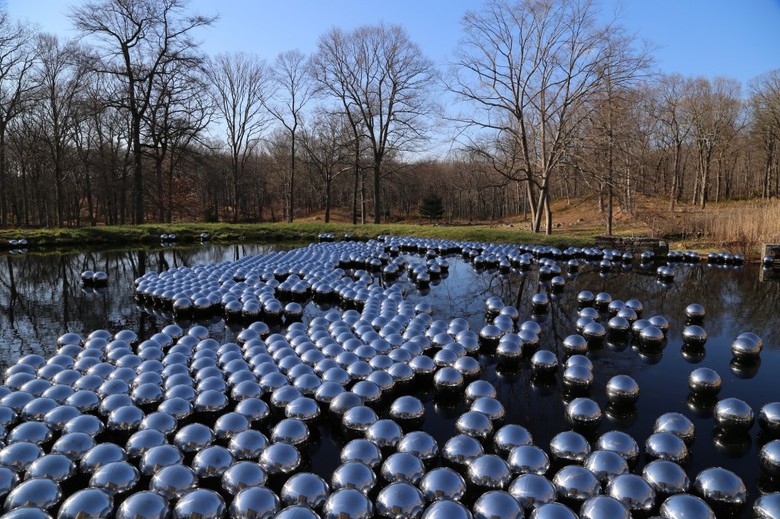
➼ Spiral Jetty
Details
By Robert Smithson
1970
earthwork: mud, precipitated salt crystals, rocks, water coil
Found in Great Salt Lake, Utah
Form
A coil of rock placed in a part of the Great Salt Lake that is in an extremely remote and inaccessible area.
The artist liked the site because of the blood-red color of the water, which is due to the presence of bacteria and algae that live in the high-salt content.
Material: The artist used a tractor to move basalt from the adjacent hillside to create the jetty.
Context
Upon walking on the jetty, the twisting and curling path changes the viewer’s view from every angle.
A jetty is usually a pier extending into the water; here it is transformed into a curl of rocks sitting silently in a vast, empty wilderness.
The coil is an image seen in North American earthworks—cf. Great Serpent Mound, Ohio—as well as in petroglyphs and Anasazi pottery.
The work reflects emerging views of the environmental movement; Earth Day was inaugurated in 1970.
Smithson wanted nature to have its effect on the jetty (sometimes it is submerged, sometimes it is visible).
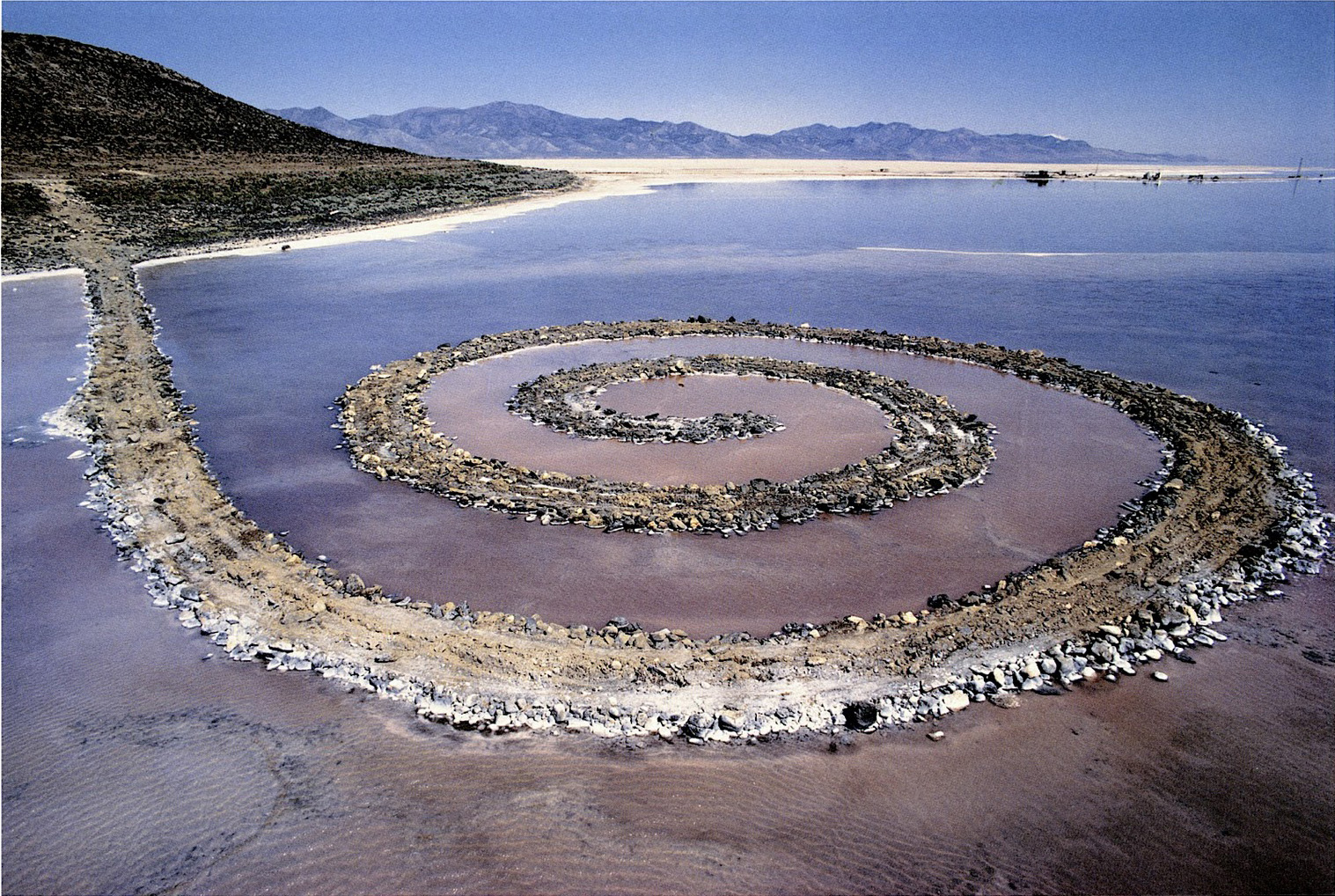
➼ House in New Castle County
Details
By Robert Venturi, John Rauch, and Denise Scott Brown
1978–1983
Made of wood frame and stucco
Found in Delaware
Form
The façade contains an arch inside a pediment form.
A squat, bulging Doric colonnade is asymmetrically placed.
The columns are actually flat rather than the traditionally round forms.
The drainpipe at the left bisects the outermost column.
The flattened forms on the interior arches echo the exterior flat columns.
The interior forms reflect a craftsman’s hand in curved, cutting elements.
Function
The house was designed for a family of three.
For the wife, a musician, a music room was created with two pianos, an organ, and a harpsichord.
For the husband, a bird-watcher, large windows were installed facing the woods.
Context
Postmodern mix of historical styles.
Rural location in low hills, grassy fields of Delaware.
Venturi’s comment on the International style: “Less is a bore.”
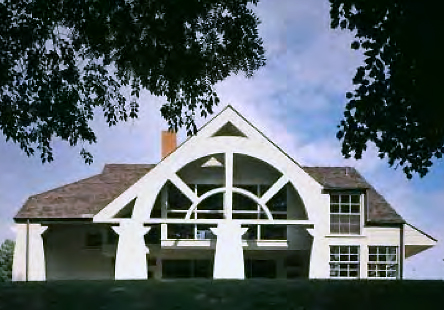
Unit 4: Later Europe and Americas, 1750–1980 CE
Key Movements of Later Europe and Americas Art
The Enlightenment (1715 – 1789)
During the Enlightenment, intellectuals and other thinkers began to see ancient concepts from a fresh viewpoint and advocated skepticism, the study of science, and reasoning over superstition.
A greater emphasis was placed on individualism and religion (separate from religion). When painters were no longer limited to religious forms, the subject matter of artwork began to change.
This age witnessed a growing appreciation for the natural world.
This paved the way for the creation of numerous new artistic trends and genres.
French Revolution (1789-1799)
People revolted at the unequal treatment of the Third Estate (commoners) by the government, persistent food shortages, and financial distress after fighting in the American Revolution.
Symbolism in a number of paintings expressed political opinions and conveyed political messages about the current events.
Romanticism, which concentrated on emotion and expressed the sublime, was one of the aesthetic trends that followed the French Revolution.
Publishing of the Communist Manifesto (1848)
The Communist Manifesto was written by Karl Marx and Friedrich Engels in 1848.
It was first published in German in London.
This was commissioned by the Communist League, a political organization that sought to unite various socialist groups.
The text outlines the principles of communism and critiques capitalism.
The Manifesto argues that the history of society is a history of class struggle, and that the proletariat (working class) will eventually overthrow the bourgeoisie (capitalist class).
The Manifesto had a significant impact on political and social movements around the world, and is considered one of the most influential political texts in history.
Revolutions of 1848
The Revolutions of 1848 were a series of political uprisings across Europe.
They were sparked by economic hardship, political repression, and demands for greater democracy and national unity.
The revolutions began in France in February 1848 and quickly spread to other countries including Germany, Italy, and Austria-Hungary.
Many of the revolutions were ultimately unsuccessful, with conservative forces reasserting control in most countries by the end of the year.
The revolutions did lead to some important reforms, such as the abolition of serfdom in Austria-Hungary and the establishment of a constitutional monarchy in France.
Perry Expedition and the Forced Opening of Japan (1853-1868)
Perry Expedition occurred between 1853-1854
Led by Commodore Matthew Perry of the United States Navy
Goal was to establish diplomatic relations with Japan and open trade
Japan had been isolated from the rest of the world for over 200 years
Negotiations were difficult due to language and cultural barriers
Treaty of Kanagawa was signed in 1854, allowing American ships to refuel and resupply in two Japanese ports
This forced Japan to open up to the world and establish trade relations with other countries
World Wars I and II (1914-1945)
Both World Wars I and II had a profound impact on global economy, populations, and the environment.
Like to earlier wars in history, art from World War I and World War II contains messages about the political and social climate.
In particular, World War I gave rise to artistic styles such as Surrealism (abstract form intended to perplex the observer) and Expressionism (work that conveyed the creators' inner sentiments).
The Harlem Renaissance (1920s-1930s)
The Harlem Renaissance was a cultural movement that took place in the 1920s and 1930s in Harlem, New York City.
It was also known as the "New Negro Movement" and was characterized by a celebration of African American culture, art, music, and literature.
The movement was fueled by the Great Migration, which brought thousands of African Americans from the South to the North in search of better opportunities.
Prominent figures of the Harlem Renaissance include Langston Hughes, Zora Neale Hurston, Duke Ellington, and Louis Armstrong.
The movement had a significant impact on American culture and helped to break down racial barriers and stereotypes.
Interactions Within and Across Cultures in Later European and American Art
Influences of Non-Western Cultures
Non-Western cultures, such as African, Asian, and Native American, influenced later European and American art.
Artists were fascinated by the exoticism and spirituality of these cultures.
They incorporated non-Western motifs, patterns, and techniques into their works.
Influences of Eastern Cultures
Eastern cultures, such as Japanese and Chinese, also influenced later European and American art.
Artists were attracted to the simplicity, elegance, and harmony of these cultures.
They adopted Eastern techniques, such as woodblock printing and calligraphy, and incorporated them into their works.
Influences of Other Western Cultures
Western cultures also influenced later European and American art.
Artists were inspired by the art of their contemporaries and predecessors from other Western countries.
They borrowed styles, techniques, and themes from these artists.
Artistic Movements of Later Europe and Americas Art
Rococo (1700-1750 CE)
Rococo art, which emerged in Europe between 1700 and 1750 CE, was characterized by its ornate and decorative style.
Techniques and processes used in Rococo art included delicate brushwork, pastel colors, and asymmetrical compositions.
Audience was primarily the aristocracy and wealthy bourgeoisie, who commissioned works for their homes and palaces.
Interpretations vary, but it is often seen as a reflection of the hedonistic and pleasure-seeking culture of the time.
Purpose was to create a sense of luxury and opulence, and to showcase the wealth and status of the patrons who commissioned the works.
Neoclassicism (1750-1830)
A revival of classical art and architecture, characterized by a focus on simplicity, order, and rationality.
Techniques included drawing, painting, and sculpture.
The audience was mainly the aristocracy and the bourgeoisie.
The purpose was to promote the values of reason, order, and patriotism.
Romanticism (1780-1850)
An artistic and literary movement that emphasized emotion, imagination, and individualism.
Techniques included painting, literature, and music.
The audience was mainly the middle class.
The purpose was to express personal feelings and emotions, and to critique society.
Realism (1848-1900)
An artistic movement that aimed to represent reality as it is, without idealization or exaggeration.
Techniques included painting, sculpture, and photography.
The audience was mainly the working class.
The purpose was to expose social and political issues, and to promote social change.
Impressionism (1860-1890)
An artistic movement that aimed to capture the fleeting effects of light and color.
Techniques included painting and drawing.
The audience was mainly the middle class.
The purpose was to capture the beauty of everyday life, and to challenge traditional art forms.
Post-Impressionism (1880s-1890s)
Emphasized the use of color and form to express emotions and ideas.
Artists used techniques such as pointillism and bold brushstrokes to create a sense of movement and energy in their works.
The purpose of Post-Impressionism was to move beyond the limitations of Impressionism and create a more personal and expressive form of art.
Symbolism (1890s)
Focused on the use of symbols and metaphors to convey deeper meanings and emotions.
Artists used techniques such as exaggeration and distortion to create a dreamlike or mystical atmosphere in their works.
The purpose of Symbolism was to explore the inner world of the human psyche and express the mysteries of the universe.
Art Nouveau (1890s-1914)
Emphasized the use of organic forms and decorative motifs inspired by nature.
Artists used techniques such as curvilinear lines and asymmetrical shapes to create a sense of fluidity and movement in their works.
The purpose of Art Nouveau was to create a new style that was both beautiful and functional, and to break away from the rigid forms of traditional art.
The Prairie Style (1900-1930s)
Emphasized the use of simple, geometric forms and natural materials such as wood and stone.
Architects used techniques such as horizontal lines and open floor plans to create a sense of harmony and integration with the surrounding landscape.
The purpose of the Prairie Style was to create a new form of architecture that was both functional and aesthetically pleasing, and to reflect the values of the American Midwest.
Fauvism (1905-1908)
Emphasized the use of bold, bright colors and simplified forms to create a sense of energy and emotion in their works.
Artists used techniques such as thick brushstrokes and simplified shapes to create a sense of spontaneity and immediacy in their works.
The purpose of Fauvism was to break away from the traditional forms of art and create a new form of expression that was both vibrant and emotional.
Expressionism (1905-1925)
An artistic movement that aimed to express subjective emotions and experiences. Techniques included painting, literature, and theater.
The audience was mainly intellectuals and artists.
The purpose was to challenge traditional art forms, and to express the anxieties and fears of modern life.
Cubism (1907-1930s)
Emphasized geometric shapes and multiple perspectives.
Its purpose was to break away from traditional art and create a new visual language.
The audience was primarily other artists and intellectuals.
Constructivism (1914-1920s)
Focused on the use of industrial materials and emphasized the importance of function over form.
Its purpose was to create art that served a social purpose and could be used in everyday life.
The audience was the working class and the goal was to inspire social change.
Dada (1915-1922)
Rejected traditional art and embraced absurdity and nonsense.
Its purpose was to challenge societal norms and values.
The audience was primarily other artists and intellectuals.
DeStijl (1917-1930s)
Emphasized simplicity and abstraction, using only primary colors and straight lines.
Its purpose was to create a universal language of art that could be understood by all.
The audience was artists and designers.
The International Style (1920s-1930s)
An architectural movement that emphasized functionality and minimalism.
Its purpose was to create buildings that were efficient and could be mass-produced.
The audience was architects and designers.
The Harlem Renaissance (1920s-1930s)
A cultural movement that celebrated African American art, literature, and music.
Its purpose was to challenge racial stereotypes and promote African American culture.
The audience was primarily African Americans.
Mexican Muralists (1920s-1930s)
Used large-scale murals to promote social and political messages.
Its purpose was to educate the public and inspire social change.
The audience was the general public.
Surrealism (1920-1960)
An artistic movement that aimed to explore the subconscious mind and the irrational.
Techniques included painting, sculpture, and literature.
The audience was mainly intellectuals and artists.
The purpose was to challenge rationality and conventional morality, and to explore the mysteries of the human psyche.
Abstract Expressionism/The New York School (1940s-1950s)
Used large canvases, gestural brushstrokes, and unconventional tools. The process of creating the artwork was as important as the final product.
Audience was primarily other artists, critics, and collectors. Interpretations varied, with some seeing it as a reaction against formalism and others as a reflection of post-World War II anxiety.
Purpose was to create a new form of art free from traditional constraints and express innermost emotions and ideas.
Pop Art (1950-1980)
An artistic movement that celebrated popular culture and consumerism.
Techniques included painting, sculpture, and graphic design.
The audience was mainly the middle class.
The purpose was to critique mass media and consumer culture, and to blur the boundaries between high and low art.
Color Field Painting (1960s)
Abstract painting style using large areas of flat color to create depth. Paint applied in multiple layers.
Primarily for art collectors and museums.
Reaction against gestural brushwork of Abstract Expressionism.
Goal was to create an immersive experience for the viewer.
Happenings (1960s)
Performance art that was spontaneous and unscripted. Included music, dance, and multimedia elements.
Aimed at young, countercultural crowds.
Meant to break down boundaries between art and life.
Goal was to create a sense of community and shared experience.
Site Art (1970s-1990s)
Art movement that created site-specific works.
Techniques included sculpture, installation, and environmental art.
Audience was often the general public in public spaces.
Goal was to engage with the environment and challenge traditional notions of art.
Aimed to create a sense of place and dialogue between art and the natural world.
Later Europe and Americas Artworks
➼ Portrait of Sor Juana Inés de la Cruz
Details
By Miguel Cabrera
1750
Made oil on canvas
Found in Museo Nacional de Historia, Castillo de Chapultepec, Mexico
Function
Many portraits survive, but all images derive from a now-lost self-portrait.
Painting was done for her admirers 55 years after Sor Juana Inés’s death.
Content
Portrayed seated in her library surrounded by symbols of her faith and her learning.
She wears the habit of the religious order of the Hermits of Saint Jerome nuns of Mexico City; the habit includes the escudo—a framed vellum painting.
Painting may have been inspired by the image of Saint Jerome seated at a desk.
Escudo: a framed painting worn below the neck in a colonial Spanish painting
Context
Sor Juana Inés (Sister Juana Agnes), a child prodigy (1651–1695).
She was a criollo woman who became a nun in 1669.
A feminist culture survived in Mexican convents, where privileged nuns could live in comfort with servants and households.
Sor Juana was a literary figure who wrote books that were widely read; she also wrote poetry and theatrical pieces, and maintained a great library.
Sor Juana was instrumental in giving girls an education in a male-dominated world.

➼ The Swing
Details
By Jean-Honoré Fragonard
1767
Made of oil on canva
Found in Wallace Collection, London
Form
Pastel palette; light brushwork.
Figures are small in a dominant garden-like setting.
Use of atmospheric perspective.
Puffy clouds; rich vegetation; abundant flowers; sinuous curves.
Symbolically a dreamlike setting.
Patronage and Content
Commissioned by an unnamed “gentleman of the Court:” a painting of his young mistress on a swing; in an early version, a bishop is pushing the swing with the gentleman admiring his mistress’s legs from below.
In the finished painting, the older man is no longer a priest, a barking dog has been added, and Falconet’s sculpture of Menacing Love comments on the story.
The patron in the lower left looks up the skirt of a young lady who swings flirtatiously, boldly kicking off her shoe at a sculpture.
The dog in the lower right corner, generally seen as a symbol of fidelity, barks in disapproval at the scene before him.
Context
Fragonard answers the libertine intentions of his patron by painting in the Rococo style.
Fragonard often used different styles at the same time, and he seems to have seen the Rococo as particularly appropriate for an erotic scene.
An intrigue painting; the patron hides in a bower; the garden sculpture of Menacing Love asks the lady to be discreet and may be a symbol for the secret hiding of the patron.

➼ Still Life in Studio
Details
By Louis-Jacques-Mande Daguerre
1837
Daguerreotype
French Photographic Society, Paris
Form
Photograph reproduces a variety of textures: fabric, wicker, plaster, framed print, etc.
Inspired by painted still lifes, such as vanitas paintings.
Context
New art form proclaimed while referencing older art forms.
Daguerreotypes have a shiny surface and a sharp eye for detail.
No negative; therefore, copies could not be made.
Long exposure times required.
Produced on a metallic surface; photos have a glossy finish.
➼ Starry Night
Details
By Vincent van Gogh
1889
Oil on canvas
Found in Museum of Modern Art, New York
Form
Thick, short brushstrokes.
Heavy application of paint called impasto.
Parts of the canvas can be seen through the brushwork; artist need not fill in every part of the surface.
Strong left-to-right wave-like impulse in the work broken only by the tree and the church steeple.
The tree looks like green flames reaching into a sky that is exploding with stars over a placid village.
Context
The mountains in the distance are the ones that Van Gogh could see from his hospital room in Saint-Rémy; steepness exaggerated.
Combination of images: Dutch church, crescent moon, Mediterranean cypress tree.
Cypresses were often associated with cemeteries.
Landscape painting was popular in the late nineteenth century as a reaction to the industrialization of cities.

➼ The Scream
Details
By Edvard Munch
1893
Tempera and pastels on cardboard
Found in National Gallery, Oslo
Form and Content
The figure walks along a wharf; boats are at sea in the distance.
Long, thick brushstrokes swirl around the composition.
The figure cries out in a horrifying scream; the landscape echoes his emotions.
Discordant colors symbolize anguish.
Emaciated, twisting stick figure with skull-like head.
Function: Painted as part of a series called The Frieze of Life; a semi autobiographical succession of paintings.
Context
Said to have been inspired by an exhibit of a Peruvian mummy in Paris.
The work prefigures Expressionist art.
The work is influenced by Art Nouveau swirling patterns.

➼ The Kiss
Details
By Gustav Klimt
1907–1908
Oil and gold leaf on canvas
Found in Austrian Gallery, Vienna
Form
Little of the human form is actually seen: two heads four hands, two feet.
The bodies are suggested under a sea of richly designed patterning.
The work is spaced in an indeterminate location against a flattened background.
Context
The male figure is composed of large rectangular boxes; the female figure is composed of circular forms.
The work suggests all-consuming love; passion; eroticism.
The use of gold leaf is reminiscent of Byzantine mosaics
The work is influenced by gold applied to medieval illuminated manuscripts.
Part of a movement called the Vienna Succession, which broke away from academic training in schools at that time.

➼ Louis Sullivan, Carson, Pirie, Scott and Company Building
Details
1899–1903
Iron, steel, glass, and terra cotta
Found in Chicago
Form
Horizontal emphasis on the exterior mirrors the continuous flow of floor space on the interior.
The exterior is covered in decorative terra cotta tiles; original interior ornamentation elaborately arranged around lobby areas, hallways, elevator; interior ornamentation now lost.
The architect designed maximum window areas to admit light, but also to make displays visible from the street.
Nonsupportive role of exterior walls; held up by an interior framework.
Open ground plan allows for free movement of customers and goods.
Function: A department store on a fashionable street in Chicago.
Context
Some historical touches exist in the round entrance arches and the heavy cornice at the top of the building.
Cast iron decorative elements transformed the store into a beautiful place to buy beautiful things.
Shows the influence of Art Nouveau in decorative ironwork on the entrance.
Sullivan motto: “Form follows function.”

➼ Goldfish
Details
By Henri Matisse
1912
Oil on canvas
Formerly in Pushkin Museum of Art, Moscow, Russia
Form
Strong contrasts of color.
Thinly applied colors; the white of the canvas shows through.
Energetic, painterly brushwork.
Broad patches of color anticipate color-field painting later in the century.
Content
Still-life painting.
Compare to Ruysch, Fruits and Insects, and Daguerre, Still Life in Studio.
Context
May have been in response to a trip in Morocco, where Matisse noted how the local population would daydream for hours, gazing into goldfish bowls. Form, color, and subject matter were inspired by this trip.
Admired the relaxed and contemplative lifestyle of the Moroccans, which symbolized a meditative state of mind and a sense of paradise lost to Europeans.
May have been influenced by the decorative quality of Asian art and diverse cultures from North Africa.

➼ Improvisation 28 (2nd Version)
Details
By Vassily Kandinsky
1912
Oil on canvas
Found in Guggenheim Museum, New York
Form
Strongly articulated use of black lines.
Colors seem to shade around line forms.
Content
Using schematic means, Kandinsky depicts cataclysmic events on the left (boat and waves—a deluge, a serpent, a cannon) and a sense of spiritual salvation on the right (a couple embrace, a candle, a church on a hill).
Context
Kandinsky wanted the viewer to respond to a painting the way one would to an abstract musical composition: a concerto, a sonata, a symphony.
The artist felt that sound and color were linked; for example, it was possible to hear color.
He used words such as “composition” and “improvisation” in the titles of his works, words associated with musical composition.
Kandinsky’s works have a relationship to atonal music, which was evolving at this time.
Movement toward abstraction; representational objects suggested rather than depicted.

➼ Self-Portrait as a Soldier
Details
By Ernst Ludwig Kirchner
1915
Oil on canvas
Found in Allen Memorial Art Museum, Oberlin College, Oberlin, Ohio
Form
Nightmarish quality.
Colors are nonrepresentational but symbolic, chosen to provide a jarring impact. Expressive quality of horrified facial features and grim surroundings.
Tilted perspective moves things closer to the picture plane.
Main figure has a drawn face, with a cigarette hanging loosely from his lips.
The eyes are unseeing and empty, without pupils; the iris reflects the blue of his uniform.
The bloody stump of a hand represents losses in war, loss of the artist’s ability to paint, his creativity, his artistic vision, and his inspiration.
Sharp angular lines reinforce a sense of violence and anxiety.
Context
Kirchner became an “unwilling volunteer,” a driver in the artillery in World War I, to avoid being drafted into the infantry.
He is wearing the uniform of his field artillery regiment.
He was declared unfit for service; he had lung problems and weakness and suffered a mental breakdown—there is scholarly debate as to whether he faked these ailments to avoid service.
This self-portrait was painted during a recuperation period.
His life was plagued by drug abuse, alcoholism, and then paralysis.
The artist feared that war would destroy his creative powers.

➼ Memorial Sheet for Karl Liebknecht
Details
By Käthe Kollwitz
1919–1920
Woodcut
A Private Collection
Form
Stark black and white of the woodcut used to magnify the grief.
Human grief dominates.
Patronage: Family of Liebknecht asked Kollwitz to memorialize him.
Technique
Wood-block print.
Kollwitz used this technique to reinforce the emotions depicted in the scene.
She liked the “primitive” quality that wood-block prints could render.
Context
Liebknecht was among the founders of the Berlin Spartacus League, which became the German Communist Party.
In 1919, Liebknecht was shot to death during a Communist uprising in Berlin called the Spartacus Revolt (named for the slave who led a revolt against the Romans in 73 B.C.E.).
Liebknecht was held to be a martyr in the Communist cause.
There are no political references in the woodcut.
Themes of war and poverty dominate the artist’s oeuvre.
She often emphasized the theme of women grieving over dead children; her son died in World War I; the artist then became a socialist.

➼ Les Demoiselles d’Avignon
Details
By Pablo Picasso
1907
Oil on canvas
Found in Museum of Modern Art, New York
Content
Depicts five prostitutes in a bordello in Avignon Street in Barcelona, each posing for a customer.
Poses are not traditionally alluring but awkward, expressionless, and uninviting.
Form
The three on the left are more conservatively painted; the two on right more radical; reflects a dichotomy in Picasso.
Multiple views are expressed at the same time.
Depth is limited, but ambiguous and ever shifting.
The painting has semitransparent passages.
Context
This is the first cubist work, influenced by late Cézanne and perhaps African masks (faces on the right) and ancient Iberian sculpture (figure on the left).
Influenced by Gauguin’s so-called Primitivism.

➼ The Portuguese
Details
By Georges Braque
1911
Oil on canvas
Art Museum, Basel, Switzerland
Form
Braque rejected naturalistic and conventional painting.
Fractured forms; breaking down of objects into smaller forms.
Clear-edged surfaces at the front of the picture plane, not recessed in space.
Nearly monochrome.
Context
Analytical Cubism; Braque worked in concert with Pablo Picasso to develop this style.
This is not a portrait of a Portuguese musician, but rather an exploration of shapes.
The only realistic elements are the stenciled letters and numbers; perhaps they suggest a dance hall poster behind the guitarist, a café-like atmosphere.

➼ The Steerage
Details
By Alfred Stieglitz
1907
photogravure
A private collection
Form
Interested in compositional possibilities of diagonals and lines acting as framing elements.
Diagonals and framing effects of ladders, sails, steam pipes, etc.
Stieglitz photographed the world as he saw it; he arranged little, and allowed people and events to make their own compositions.
Influenced by experimental European painting; compared with a Cubist drawing by Picasso, Cubist-like in arrangement of shapes and tonal values.
Content
Steerage: the part of a ship reserved for passengers with the cheapest tickets.
Depicts the poorest passengers on a ship traveling from the United States to Europe in 1907; they were allowed out for air for a limited time.
Some may have been people turned away from entrance to the United States; more likely, they were artisans whose visas had expired and were returning home.
Context
The work depicts social divisions in society.
Published in October 1911 in Camera Work.

➼ Fountain
Details
By Marcel Duchamp
Originally 1917; this version is 1950
readymade glazed sanitary china with black paint
Found in Philadelphia Museum of Art, Pennsylvania
Form
Ready-made sculpture; actually a found object that Duchamp deemed to be a work of art.
Signed by the “artist,” R. Mutt, a pun on the Mutt and Jeff comic strip and Mott Iron Works.
Item purchased from a sanitary-ware supplier and submitted to the Society of Independent Artists, a group that Duchamp helped to found.
Function and History
Entered in an unjuried show, the work was refused—narrowly voted out by the organizers.
Thought to be indecent, not fit to show women.
Duchamp resigned in protest.
It is not fully understood why Duchamp resigned; it may have come from his experience exhibiting an earlier work Nude Descending a Staircase No. 2 to the Salon des Indépendants in Paris; although the work was illustrated in the show’s catalog, Duchamp was asked to remove it a few days before the opening.
He removed the object but felt betrayed; said it was a turning point in his life.
Fountain can be seen as an experimental replay by Duchamp, testing the commitment of the new American Society to freedom of expression and tolerance of new conceptions about art.
Context
The title is a pun: a fountain spouts liquid, a urinal collects it.
The placing of the urinal upside down is an added irony.
The rotation of Fountain may symbolize seeing something familiar from a new perspective.
The original is now lost; Duchamp oversaw the “remaking” of a few models in 1964.
➼ Object (Le Dejéuner en fourrure)
Details
By Meret Oppenheim
1936
fur-covered cup, saucer, and spoon
Found in Museum of Modern Art, New York
Form: An assemblage.
Context
Said to have been done in response to Picasso’s claim that anything looks good in fur; Oppenheim said to respond, “Even this cup and saucer?”
Erotic overtones.
Combination of unalike objects: fur-covered teacup, saucer, and spoon. The tea cup was purchased at a department store; the fur is the pelt of a Chinese gazelle.
A contrast of textures: fur delights the touch, not the taste; cups and spoons are meant to be put in the mouth.
Oppenheim did not title the work, but the Surrealist critic, Andre Breton, called the piece Le Déjeneur en fourrure, or Luncheon in Fur, a title that references Édouard Manet’s Luncheon on the Grass as well as the erotic novel by Leopold von Sacher-Masoch called Venus in Furs.
Chosen by visitors to a Surrealist show in New York as the quintessential Surrealist work of art.
Because fame came to Oppenheim so young (she was twenty-two when she produced this work), it inhibited her growth as an artist.

➼ The Two Fridas
Details
By Frida Kahlo
1939
oil on canvas
Found in Museum of Modern Art, Mexico City
Content
On the left: Kahlo is dressed as a Spanish lady in white lace, linking her to a European heritage.
On the right: Kahlo dressed as a Mexican peasant—the stiffness and provincial quality of Mexican folk art was a direct inspiration for the artist.
Behind is a barren landscape; two figures sit against a wildly active sky.
Context
There is a juxtaposition to two self-portraits.
Kahlo’s two hearts are joined together by veins that are cut by scissors at one end and lead to a portrait of her husband, artist Diego Rivera, at the other; painted at the time of their divorce.
The vein acts as an umbilical cord; symbolism: Rivera as both husband and son.
Blood on her lap suggests many abortions and miscarriages; also, surgeries related to her health issues.
Kahlo rejected the label Surrealism for her artwork.

➼ The Jungle
Details
By Wifredo Lam
1943
gouache on paper mounted on canvas
Found in Museum of Modern Art, New York
Form
Crescent-shaped faces suggest African masks and the god Elegua.
Rounded backs, thin arms and legs, pronounced hands and feet.
Long vertical lines suggest sugarcane, which is grown in fields, not jungles.
Context
Cuban-born artist whose career took him to Europe and the United States.
The artist was interested in Cuba’s mixture of Hispanic and African cultures.
This work was “intended to communicate a psychic state.”
The work addresses the history of slavery in colonial Cuba.
Influences include African sculpture; Cubist works; Surrealist paintings (Lam was a member of the Surrealist movement in Paris).
The painting contrasts a Cuban landscape with a tourist image of Cuba as a tropical paradise.

➼ Illustration from The Results of the First Five-Year Plan
Details
By Varvara Stepanova
1932
photomontage
Found in Museum of the Revolution, Moscow, Russia
Form and Function
Graphic art for political and propaganda purposes; a photomontage.
Red color dominates—the color of Communist Soviet Union.
A large portrait of Lenin dominates; although deceased, his image is used to stimulate patriotism.
Masses of people below illustrate the popularity of the Five-Year Plan.
CCCP (Союз Советских Социалистических Республи) is a Russian abbreviation for the Soviet Union.
Context
Stepanova was one of the main figures in the Russian avant-garde movement.
Influenced by Cubism and Futurism.
Five-Year Plan:
Soviet practice of increasing agricultural and industrial output in five years.
Launched in 1928, considered complete in 1932.
Emphasis on growth of heavy industry rather than consumer goods.
Huge increases in electrical output (dominant industrial symbol in the work).
The failures of the five-year plan are overlooked in this representation (famine, extreme poverty, political oppression); instead it is a propaganda statement of the virtues of the Stalinist state.

➼ Composition with Red, Blue and Yellow
Details
By Piet Mondrian
1930
oil on canvas
Found in Kunsthaus,Zurich
Form
Only primary colors used—red, yellow, and blue—plus the neutral colors, white and black.
Severe geometry of form; only right angles; grid-like forms.
No shading of colors.
Context
The artist is interested in the material properties of paint, not naturalistic depictions.
The artist expresses ideas using abstract elements—that is, line and color.
Influenced by Cubism.

➼ Fallingwater
Details
By Frank Lloyd Wright
1936–1939
reinforced concrete, sandstone, steel, and glass
Found in Bear Run, Pennsylvania
Form
Cantilevered steel-supported porches extend over a waterfall.
The accent is on horizontal lines—as opposed to the verticality of much of twentieth-century architecture.
The architecture is in harmony with the site.
The living room contains a glass curtain wall around three of the four sides; the building embraces the woods around it.
The floor of the living room and the walls of building are made from the stone of the area.
The hearth (physically and symbolically) is the center of the house, an outcropping of natural stones surrounds it.
The interior shows a suppression of space devoted to hanging a painting; Wright wanted the architecture to dominate.
The ground plan and design is irregular and complex.
Only two colors used: light ochre for the concrete and Cherokee red for the steel.
Context: Late expression of Prairie School ideas.
Function and Patronage: Weekend retreat for the Kaufmann family, who owned a department store in Pittsburgh, Pennsylvania.

➼ Villa Savoye
Details
By Le Corbusier
1929
steel and reinforced concrete
Found in Poissy-sur-Seine, France
Form
Boxlike horizontal quality; an abstraction of a house.
The main part of the house is lifted off the ground by narrow pilotis—thin freestanding posts.
The house appears to float on pilotis; allows air to circulate around the base of the house.
The turning circular carport on the bottom floor enables family members to enter the house directly from their car.
All space is utilized, including the roof, which acts as a patio.
The roof terraces bring the outdoors into the house.
Subtle colors: white on exterior symbolizes modern cleanliness and healthful living.
Open interior is free of many walls.
Some furniture is built into the walls.
Ribbon windows wind around the second floor.
Streamlined look.
Living spaces that are surrounded by glass face an open courtyard-type setting on the second floor.
Function and Patronage
A three-bedroom country house with servants’ quarters on the ground floor.
Built in suburban Paris as a retreat for the wealthy.
Patrons: Pierre and Emilie Savoye.

➼ Seagram Building
Details
By Ludwig Mies van der Rohe and Philip Johnson
1954–1958
steel frame with glass curtain wall and bronze
Found in New York
Function: 38-story corporate headquarters of the Seagram Liquor Company.
Form
Bronze veneer gives the skyscraper a monolithic look; bronze is maintained yearly to keep the same color.
Set back from Park Avenue on a wide plaza balanced by reflecting pools.
Interplay of vertical and horizontal accents.
Mullions stress the verticality of the internal frame.
Context
Minimalist architecture.
Monolith style expresses corporate power.
Mies’s saying of “Less is more” can be seen in this building with its great simplicity, geometry of design, and elegance of construction.
Mies also said, “God is in the details;” truthful buildings express their structure, not hide it.
Steel and glass skyscrapers and curtain wall construction became the model after World War II.
A triumph of the International Style of architecture.

➼ The Migration of the Negro, Panel no. 49
Details
By Jacob Lawrence
1940–1941
casein tempera on hardboard
Found in Museum of Modern Art, New York
Form
The work illustrates the collective African-American experience; therefore, there is little individuality in the figures.
Forms hover in large spaces.
Angularity of forms.
Tilted tabletops show the surface of the table.
Flat, simple shapes.
Unmodulated colors.
Collective unity achieved by painting one color across many panels before going on to the next color; overall color unity in the series unites each painting.
Content
This scene involves a public restaurant in the North; segregation emphasized by the yellow poles that zigzag down the center.
Whites appear haughty and self-engrossed.
African-Americans appear faceless; forms reveal their bodies and personalities.
Context
One of a series of 60 paintings that depicts the migration of African-Americans from the rural South to the urban North after World War I.
Negroes escaping the economic privation of the South.
Narrative painting in an era of increasing abstraction.
Cinematic movement of views of panels: some horizontal and others vertical.
Influenced by the Italian masters of the fourteenth and fifteenth centuries; used tempera paint.
The Phillips Collections in Washington, D.C., and the Museum of Modern Art in New York bought the collection and it was split.
The Phillips took the odd-numbered paintings; the Museum of Modern Art has the even-numbered ones.

➼ Dream of a Sunday Afternoon in the Alameda Park
Details
By Diego Rivera
1947–1948
fresco
Found in Museo Mural Diego Rivera, Mexico City
Form
50-foot-long fresco, 13 feet high.
Horror vacui; didactic painting.
Colorful painting.
Revival of fresco painting, a Mexican specialty.
Placement
Originally in the lobby of the Hotel del Prado.
After a 1985 earthquake destabilized the hotel, the fresco was placed in a museum adjacent to Alameda Park, Mexico City’s first city park—built on the grounds of an Aztec marketplace.
Content
Three eras of Mexican history depicted from left to right:
Conquest and colonization of Mexico by the Spanish.
Porfirio Diaz dictatorship.
Revolution of 1910 and the modern world.
Depicts a who’s who of Mexican politics, culture, and leadership:
Sor Juana, in nun’s habit, at left center.
Benito Juárez, five-term president of Mexico, left at top.
General Santa Ana handing the keys of Mexico to General Winfield Scott.
Emperor Maximilian and Empress Carlota.
José Marti, father of Mexican independence (tipping his hat).
General Porfirio Díaz, with medals, asleep.
A police officer ordering a family out of an elitist park.
Francisco Madero, a martyred president.
José Posaro, artist and Rivera hero.
Rivera is in the center, at age ten, holding hands with Caterina (“Death”) and dreaming of a perfect love (Kahlo is behind him holding a yin/yang symbol—a symbol of Kahlo and Rivera’s relationship).

➼ Woman I
Details
By Willem de Kooning
1950–1952
oil on canvas
Found in Museum of Modern Art, New York
Form
Ferocious woman with great fierce teeth and huge eyes.
Large, bulbous breasts satirize women who appear in magazine advertising; smile said to be influenced by an ad of a woman selling Camel cigarettes.
Jagged lines create an overpowering image.
The smile is a cut out of a female smile from a magazine advertisement.
Blank stare; frozen grin.
Ambiguous environment: vagueness, insecurity.
Thick and thin black lines dominate.
Context
Combination of stereotypes; ironic comment on the banal and artificial world of film and advertising.
Commentary on the female form in art history.
Is she aggressive? Or have aggressions been committed against her? Or both?
One of a series of six paintings on this theme.
Influenced by everything from paleolithic goddesses to pin-up girls

➼ The Bay
Details
By Helen Frankenthaler
1963
acrylic on canvas
Found in Detroit Institute of Arts, Detroit, Michigan
Form
Painted directly on an unprimed canvas; canvas absorbs the paint more directly.
Use of runny water-based acrylic paint.
Soak-stained technique.
Use of landscape as a starting point, a basis for imagery in the works.
The two-dimensionality of the canvas is accentuated.
Context and Interpretation: Artist worked in the avant-garde New York School at mid-century.

➼ Marilyn Diptych
Details
By Andy Warhol
1962
oil, acrylic, silkscreen enamel on canvas
Found in Tate Gallery, London
Form and Content
Marilyn Monroe’s public face appears sequentially as if on a roll of film.
Fifty images from a film still from a movie, Niagara (1953).
Social characteristics magnified: brilliance of blonde hair, heavily applied lipstick, seductive expression.
Private persona of the individual submerged beneath the public face.
Marilyn’s public face appears highlighted by bold, artificial colors.
Left, in color, represents her in life; right, in black and white, represents her in death; work done four months after her tragic death.
Repetition of faces reflects the repetition of the number of times Marilyn appeared before the public; sometimes overexposed, sometimes underexposed.
Materials and Technique
Silkscreen printing technique applies photographic images in rectangular shapes onto a canvas background.
Silkscreen diminishes the role of shading and emphasizes broad planes and unmodulated color.
Diptych format suggests almost a religious presence.
Context
Cult of celebrity; Monroe was a famous movie star of the 1950s.
Private persona of Marilyn submerged beneath the public face(s).
Repeated imagery drains the image of Monroe of meaning.
Reproduction of many denies the concept of the unique work of art.

➼ Lipstick (Ascending) on Caterpillar Tracks
Details
By Claes Oldenburg
1969–1974
cor-ten steel, steel, aluminum, and cast resin, painted with polyurethane enamel
Found in Yale University, New Haven, Connecticut
Function
First installed, secretly, on Beinecke Plaza, New Haven, in 1969.
Intended as a platform for public speakers; rallying point for anti-Vietnam-era protests.
Materials
Sculpture made of inexpensive and perishable materials (plywood tracks and an inflatable vinyl balloon tip).
Refurbished with steel and aluminum; reinstalled in 1974 in front of Morse College, at Yale—not its original location.
Context
Tank-shaped platform base with lipstick ascending—antiwar symbolism.
Male and female forms unite: themes of death, power, desire, and sensuality.
First monumental sculpture by Oldenburg.

➼ Narcissus Garden
Details
By Yayoi Kusama
first seen in 1966
marble installations
Found in Venice
Function and History
The artist originally featured the work as an uninvited participant in the 1966 Venice Biennale.
Fifteen hundred large, mirrored, plastic balls were placed on a lawn under a sign that said “Your Narcissism for Sale.”
The viewer is reflected seemingly into infinity in the mirrored surfaces.
The artist offered the balls for sale for 1,200 lire ($2 each) as a commentary on the commercialism and vanity of the current art world.
The installation later moved to water, where the floating balls reflect the natural environment—and the viewers—around the work; water placement makes a stronger connection to the ancient myth.
Balls move with the currents of the water and wind, reflecting organically made, ever-changing viewpoints.
The installation has been exhibited in many places around the world, both in water and in dry spaces
Context
Narcissus Garden references the ancient myth of Narcissus, a young man who is so enraptured by his image in reflecting water that he stares at it indefinitely until he becomes a flower.
There is a deeper meaning today as Narcissus Garden references modern obsessions with selfies and uploaded images on social media.
Kusama is an internationally renowned Japanese-born artist:
Got her start showing large works of art featuring huge polka dots.
One of the foremost innovators of Happenings.
Works in a wide variety of media, including installations.

➼ Spiral Jetty
Details
By Robert Smithson
1970
earthwork: mud, precipitated salt crystals, rocks, water coil
Found in Great Salt Lake, Utah
Form
A coil of rock placed in a part of the Great Salt Lake that is in an extremely remote and inaccessible area.
The artist liked the site because of the blood-red color of the water, which is due to the presence of bacteria and algae that live in the high-salt content.
Material: The artist used a tractor to move basalt from the adjacent hillside to create the jetty.
Context
Upon walking on the jetty, the twisting and curling path changes the viewer’s view from every angle.
A jetty is usually a pier extending into the water; here it is transformed into a curl of rocks sitting silently in a vast, empty wilderness.
The coil is an image seen in North American earthworks—cf. Great Serpent Mound, Ohio—as well as in petroglyphs and Anasazi pottery.
The work reflects emerging views of the environmental movement; Earth Day was inaugurated in 1970.
Smithson wanted nature to have its effect on the jetty (sometimes it is submerged, sometimes it is visible).

➼ House in New Castle County
Details
By Robert Venturi, John Rauch, and Denise Scott Brown
1978–1983
Made of wood frame and stucco
Found in Delaware
Form
The façade contains an arch inside a pediment form.
A squat, bulging Doric colonnade is asymmetrically placed.
The columns are actually flat rather than the traditionally round forms.
The drainpipe at the left bisects the outermost column.
The flattened forms on the interior arches echo the exterior flat columns.
The interior forms reflect a craftsman’s hand in curved, cutting elements.
Function
The house was designed for a family of three.
For the wife, a musician, a music room was created with two pianos, an organ, and a harpsichord.
For the husband, a bird-watcher, large windows were installed facing the woods.
Context
Postmodern mix of historical styles.
Rural location in low hills, grassy fields of Delaware.
Venturi’s comment on the International style: “Less is a bore.”

 Knowt
Knowt
